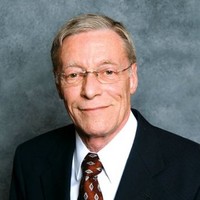
About UsThe Numismatic Bibliomania Society is a non-profit association devoted to the study and enjoyment of numismatic literature. For more information please see our web site at coinbooks.org SubscriptionsThose wishing to become new E-Sylum subscribers (or wishing to Unsubscribe) can go to the following web page link MembershipThere is a membership application available on the web site Membership Application To join, print the application and return it with your check to the address printed on the application. Print/Digital membership is $40 to addresses in the U.S., and $60 elsewhere. A digital-only membership is available for $25. For those without web access, write to: Terry White, Treasurer AsylumFor Asylum mailing address changes and other membership questions, contact Terry at this email address: terrywhite5475@yahoo.com SubmissionsTo submit items for publication in The E-Sylum, write to the Editor at this address: whomren@gmail.com
BUY THE BOOK BEFORE THE COIN |
- WAYNE'S WORDS: THE E-SYLUM JANUARY 13, 2019
- MORE KOLBE & FANNING SALE 151 HIGHLIGHTS
- NEW BOOK: GUIDE BOOK OF CIVIL WAR TOKENS, 3RD ED.
- NEW BOOK: GUIDE BOOK OF U.S. PAPER MONEY 6TH ED.
- NEW BOOK: INDIANA OBSOLETE BANK NOTES AND SCRIP
- NEW BOOK: RAILROAD STOCKS AND BONDS, 3RD ED.
- JOURNAL OF EARLY AMERICAN NUMISMATICS
- BOOK REVIEW: THE FIRST CONSPIRACY
- RICHARD BAGG, PHD (1946-2018)
- ST. LOUIS STAMP & COIN COMPANY PRICE LISTS SCANNED
- STACK'S BOWERS AUCTION ARCHIVES IMPROVED
- QUIZ ANSWERS: NUMISMATICS AND SPORTS
- ANSWER: WHAT DO THESE IMAGES REPRESENT?
- NOTES FROM E-SYLUM READERS: JANUARY 13, 2019
- HARRY BOOSEL'S 1873 OPEN AND CLOSED 3'S
- QUERY: RECOINED SOL UNDERTYPE SOUGHT
- VOCABULARY TERMS: CAST AND CHASED
- JOHN ZUG (1869-1949)
- HARVEY STACK'S NUMISMATIC FAMILY, PART 35
- HETTIE ANDERSON, MODEL FOR SAINT-GAUDENS
- THE COLUMNS OF THE SECOND PHILADELPHIA MINT
- LONGACRE'S LAST LETTER?
- CHICAGO COIN CLUB 1,200TH MEETING
- ANA ENGRAVING COURSE SCHOLARSHIPS AVAILABLE
- COIN COUNTERFEITS GET BETTER AND BETTER
- MIDDLEBURY COLLEGE ANCIENT COIN DONATION
- ROYAL MINT TO REISSUE SCARCE 50P COINS
- MEDIA COVERAGE OF LUTES 1943 COPPER CENT
- DISTRICT OF COLUMBIA BREADCOINS
- REGINA COIN SHOW FEATURES FIRST NATIONS MEDALS
- NEPAL WANTS HIGH-DENOMINATION INDIAN BANKNOTES
- PROP MONEY PODCAST
- BERLIN GOLD COIN HEIST TRIAL BEGINS
- LOOSE CHANGE: JANUARY 13, 2019
Click here to access the complete archive a
Click here to unsubscribe (scroll down)
To comment or submit articles, reply to whomren@gmail.com
Content presented in The E-Sylum is not necessarily researched or independently fact-checked, and views expressed do not necessarily represent those of the Numismatic Bibliomania Society.
WAYNE'S WORDS: THE E-SYLUM JANUARY 13, 2019
 New subscribers this week include:
Randy Carey,
Talesha Mcclasky, and
Pasquale A Paolucci.
Welcome aboard! We now have 5,816 subscribers.
New subscribers this week include:
Randy Carey,
Talesha Mcclasky, and
Pasquale A Paolucci.
Welcome aboard! We now have 5,816 subscribers.
Thank you for reading The E-Sylum. If you enjoy it, please send me the email addresses of friends you think may enjoy it as well and I'll send them a subscription (but let me know if they are located in the European Union). Contact me at whomren@gmail.com anytime regarding your subscription, or questions, comments or suggestions about our content.
This week we open with more highlights from the upcoming Kolbe & Fanning numismatic literature sale, FOUR new books, a new journal issue, a book review, and the passing of another prominent numismatic figure.
Other topics this week include the St. Louis Stamp & Coin Co., numismatics and sports, collector/dealer John Zug, coin model Hettie Anderson, engraver James Longacre, coin counterfeits, reissued 50 pence coins, the Lutes discovery 1943 bronze cent, prop money and Breadcoins.
To learn more about Indiana obsolete banknotes and scrip, colonial minter Walter Mould, two coin collectors who owned the NHL Los Angeles Kings, the recoined sols, the Chicago Coin Club 100th anniversary Redbook, the Berlin giant gold coin heist trial, and the man who purchased 25,000 1909-S VDB Lincoln cents from the San Francisco Mint, read on. Have a great week, everyone!
Wayne Homren
Editor, The E-Sylum
MORE KOLBE & FANNING SALE 151 HIGHLIGHTS
Here are some additional highlights of the upcoming Kolbe & Fanning numismatic literature sale. -Editor
MORE HIGHLIGHTS FROM KOLBE & FANNING'S JANUARY 26 SALE
The January 26 numismatic book auction being held by Kolbe & Fanning Numismatic Booksellers is coming up soon. With items in over a dozen different languages on ancient, foreign and U.S. numismatics, the 500-lot sale has something for everybody.
A few notable lots include:
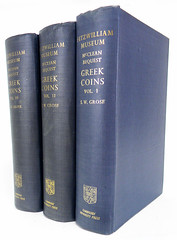
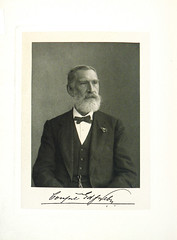
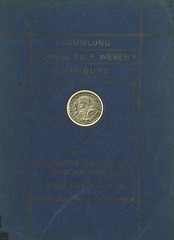
Lots 81, 97 and 99
Lot 81: Sidney Grose's classic three-volume catalogue of the McClean / Fitzwilliam Greek cabinet
Lot 97: Jacob Hirsch's massive 1908 catalogue of the Consul Weber Greek coins
Lot 99: Hirsch's 1909 offering of the Weber Roman coins

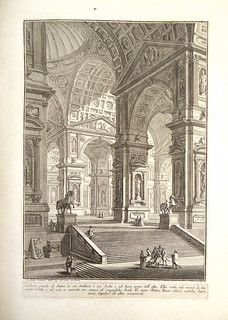
Lot 172
Lot 172: Piranesi's magnificent 1750 Opere Varie, bringing together 48 extraordinary engraved prints depicting the artist's fantastical vision of the remnants of antiquity
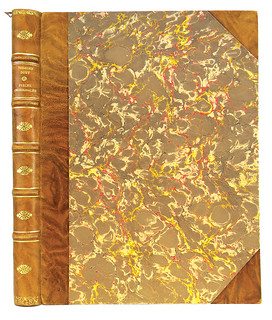
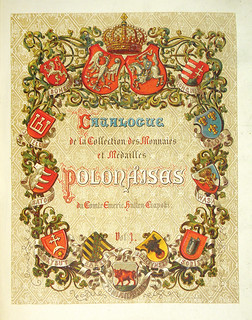
Lots 256 and 279
Lot 256: a lovely copy of Duby's rare 1786 work on obsidional coins Lot 279: a complete original set of Count Hutten-Czapski's very rare and important work on Polish coins and medals
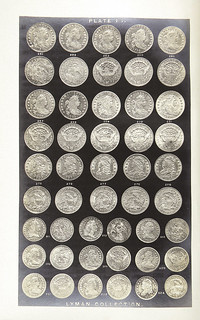
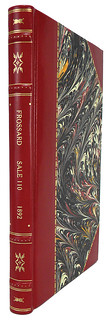
Lots 382 and 401
Lot 382: a price and named plated copy of S.H. Chapman's 1913 sale of the John Lyman collection
Lot 401: a sumptuously bound copy of Ed Frossard's rare plated 1892 catalogue of the A.H. Saltmarsh collection.
Bidders may participate in the sale online or through more traditional means. Bids may be placed via post, email, fax or phone, as well as online. Kolbe & Fanning use Auction Mobility as our third-party online bidding platform. Auction Mobility is an app-based platform allowing users the ability to participate in the sale through phones, tablets and computers. To register for the online sale, bidders must go to bid.numislit.com and sign up. Once you have set up an account, you may browse lots, place advance bids, or participate in the live sale online. Those wishing to participate on their devices can download the Kolbe & Fanning app through the Apple or Google Play Store.
The printed catalogue of Sale 151 has been mailed to active customers (foreign customers may wish to consult the online catalogue in case of delay). A PDF of the printed catalogue has been posted to our main website at numislit.com for those who prefer that format. Bids placed via post, email, fax or phone must be received by January 25, the day before the sale, in order for them to be processed. Advance absentee bids may also be placed online at bid.numislit.com; live internet bidding will be available during the sale itself through the same platform.
Kolbe & Fanning Numismatic Booksellers LLC is a licensed and bonded auction firm in the State of Ohio. For more information, please see the Kolbe & Fanning website at numislit.com or email David Fanning at df@numislit.com. To register for the sale, go to bid.numislit.com. We look forward to your participation.
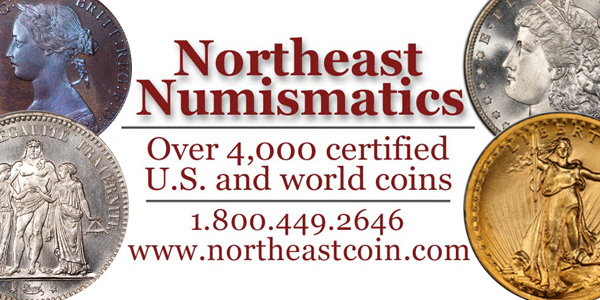
NEW BOOK: GUIDE BOOK OF CIVIL WAR TOKENS, 3RD ED.
Dennis Tucker of Whitman Publishing submitted this press release about the new edition of the Guide Book of Civil War Tokens. Thanks. -Editor
Includes Expanded Resources
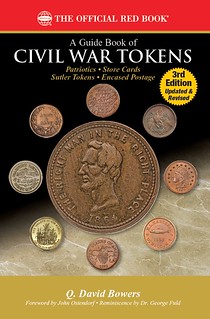 Whitman Publishing announces the release of a revised and updated third edition of the award-winning Guide Book of Civil War Tokens, by Q. David Bowers. The 512-page book debuted during the 2018 holiday season, and is now available online (including at Whitman.com) and from bookstores and hobby shops nationwide. Its retail price is $39.95.
Whitman Publishing announces the release of a revised and updated third edition of the award-winning Guide Book of Civil War Tokens, by Q. David Bowers. The 512-page book debuted during the 2018 holiday season, and is now available online (including at Whitman.com) and from bookstores and hobby shops nationwide. Its retail price is $39.95.
Civil War tokens are metal "coins" (actually not legal tender) privately issued by American tradesmen and others during the conflict. These tokens were used to advertise businesses and also to grease the wheels of commerce during the coin shortages caused by the war. By the summer of 1862, nervous citizens had hoarded all of the nation's gold and silver coins and even its small copper-nickel Flying Eagle and Indian Head one-cent coins. This caused a financial emergency as it became nearly impossible to make change for everyday transactions. Millions of private tokens became substitutes for official U.S. coins, spent and accepted as 1¢ each by the public. Today these tokens are highly collectible. Values generally range from $15 for common, circulated pieces to more than $15,000 for rarities including unique tokens. In recent years, with eBay offerings, professional auction listings, and other opportunities to buy and sell, Civil War tokens have emerged as a dynamic part of the hobby marketplace.
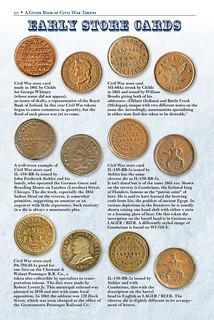

The Guide Book of Civil War Tokens is a complete history and price guide. The third edition features new resources including an index of more than 20 die-maker ascriptions, organized by maker and Fuld number. This covers the nation's most productive die-makers such as John Stanton and Emil Sigel, as well as more obscure sources including John D. Lovett and Mossin & Marr.
It also has a new index of tokens organized by the occupation or service of the issuer. This includes more than three dozen types of merchants—bakers, brewers and distillers, hoteliers, jewelers, pharmacists, doctors, saloonkeepers, and others who issued so-called store cards.
The first and second editions of the Guide Book of Civil War Tokens, released in August 2013 and December 2014, won national awards including the Token and Medal Society's Mishler Exonumia Cataloguing Award and an Extraordinary Merit Award from the Numismatic Literary Guild.
Features include an illustrated appendix on sutler tokens (private issues of government-licensed contractors who typically operated camp stores in connection with traveling military regiments); biographies of selected Civil War token engravers and coiners; information on non-contemporary issues; and an appendix on encased postage stamps (another form of emergency currency issued in 1862).
Among the third edition's features are hundreds of individually updated values based on today's market, coordinated by valuations editor Steve Hayden; and numerous edits capturing the latest research in this active field. "The vast majority of Civil War tokens are very affordable in grades of Extremely Fine or higher and range in price from a few tens of dollars to a few hundred," said Bowers. "There are so many possibilities, anyone can with care assemble a notable collection at modest expense."
Bowers, widely regarded as the "Dean of American Numismatics," wrote A Guide Book of Civil War Tokens with the cooperation of leading organizations, museums, libraries, collectors, dealers, and researchers. Also instrumental were the Civil War Token Society (in particular), the American Numismatic Society, the Token and Medal Society, and the American Numismatic Association. The book includes more than 2,000 full-color images, plus values in multiple grades, rarity ratings, detailed historical background, a study of how Civil War tokens were manufactured, ways to collect them, identification of unusual varieties, and information on the potential for valuable new discoveries. It covers both patriotic tokens and "store cards" (merchant advertising tokens), as well as sutler tokens (some of which used Civil War token dies) and encased postage stamps of the era. Nearly every known Civil War token die is described in both pictures and text.
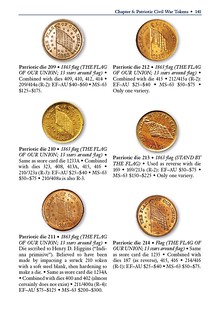
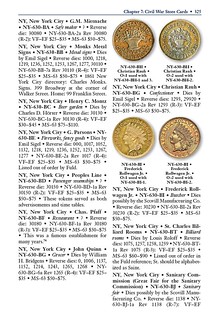
Award-winning researcher John Ostendorf calls it "a must-have book for Civil War token collectors, who will benefit from Dave Bowers's decades of research, presented in a very readable format."
"There is no other reference like the Guide Book of Civil War Tokens," said Whitman publisher Dennis Tucker. "It is the only full-color illustrated price guide to these collectible pieces of Americana. With a small investment of $39.95—about the price of a common copper token in Extremely Fine condition—a collector, dealer, or appraiser can become an expert on Civil War tokens and sutler tokens."
"No book on how to collect Civil War tokens has ever been as thorough," said Dr. George Fuld, a well-known expert in the field. "I expect that it will be a standard reference for years to come." Fred Reed, another specialist in Civil War money and past editor of the Token and Medal Society Journal, said, "Every collector of this series will esteem this volume, and every historian or serious writer on the Civil War should consult its colorful pages in the future."
In addition to being available at bookstores and online, A Guide Book of Civil War Tokens can be borrowed for free as a benefit of membership in the American Numismatic Association, through the Dwight N. Manley Numismatic Library (money.org/library). ANA members receive 10% off copies ordered through Whitman Publishing, the Official Supplier of the Association.
A Guide Book of Civil War Tokens, 3rd edition
Volume 16 in the Bowers Series
By Q. David Bowers ∙ Foreword by John Ostendorf ∙ Reminiscence by Dr. George Fuld
ISBN 0794846467 ∙ 512 pages ∙ 6 x 9 inches, softcover ∙ Full color ∙ Retail $39.95
Contents: Introduction ∙ Style, Terminology, and Arrangement Notes ∙ Chapter 1: Overview and Key to Using This Book ∙ Chapter 2: Before the Civil War ∙ Chapter 3: Money of the Civil War ∙ Chapter 4: Civil War Tokens and the History of Collecting Them ∙ Chapter 5: Aspects of Collecting Civil War Tokens ∙ Chapter 6: Patriotic Civil War Tokens ∙ Chapter 7: Civil War Store Cards ∙ Appendices: Selected Civil War Token Engravers and Coiners; Location Unknown Civil War Store Cards; Fuld Numbers Now Non-Contemporary; Non-Contemporary Store Cards, by Issuer; Encased Postage Stamps of 1862; Civil War Sutler Tokens ∙ Notes ∙ Selected Bibliography and Resources ∙ About the Author ∙ Credits and Acknowledgments ∙ General Index ∙ Index of Die-Maker Ascriptions ∙ Index of Store Cards by Occupation or Service
For more information, or to order, see:
https://www.whitman.com/store/Inventory/Detail/A-Guide-Book-of-Civil-War-Tokens-3rd-Edition+0794846467
NEW BOOK: GUIDE BOOK OF U.S. PAPER MONEY 6TH ED.
Dennis Tucker of Whitman Publishing also submitted this press release about the new edition of the Guide Book of United States Paper Money. Thanks. -Editor
Guide Book of United States Paper Money is Now Available
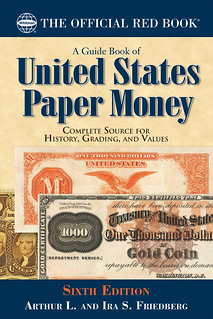 An updated and revised sixth edition of the Guide Book of United States Paper Money is available now, in January 2019. The new book is a history and price guide of the paper currency of the United States dating from Civil War federal issues to present-day cash, plus related issues. Written by award-winning numismatists Arthur L. and Ira S. Friedberg, the 416-page guide is printed in full color with hundreds of high-resolution images. It retails for $24.95 and is available online (including at Whitman.com) and from booksellers and hobby retailers nationwide.
An updated and revised sixth edition of the Guide Book of United States Paper Money is available now, in January 2019. The new book is a history and price guide of the paper currency of the United States dating from Civil War federal issues to present-day cash, plus related issues. Written by award-winning numismatists Arthur L. and Ira S. Friedberg, the 416-page guide is printed in full color with hundreds of high-resolution images. It retails for $24.95 and is available online (including at Whitman.com) and from booksellers and hobby retailers nationwide.
The Guide Book of United States Paper Money describes in detail thousands of federally issued notes—not just valuable rarities like the Demand Notes of 1861, but also currency found in our wallets today. An introduction by David L. Ganz explores topics such as the $2 bill, star notes, and World War II notes; American money in the Civil War; the Bureau of Engraving and Printing; how cash is designed, printed, and distributed; how to collect, store, and care for paper money; grading standards; and the many kinds of federal paper money printed from the 1860s to today's Series of 2017 Federal Reserve Notes with signatures of U.S. Treasurer Jovita Carranza and Treasury Secretary Steven Mnuchin. The authors cover recent developments in the hobby. They discuss the Treasury Department's changing approach to redesign of the $20 bill using a portrait of abolitionist Harriet Tubman (as well as recently postponed plans to include images of women on the $5 and $10 bills).
On the market side, the book combines the standard Friedberg cataloging system with retail values in multiple grades for each note.
Remarking on today's marketplace, Arthur Friedberg said, "Great rarities know no price limits on the few occasions that such specimens appear for sale. When they sell, the resulting publicity offers a boost to the entire market. Meanwhile, small-size type notes (non–Federal Reserve notes) are approaching a level of interest formerly held by their large-size counterparts." He described star notes (replacement notes) as being underappreciated, noting that "The market for Federal Reserve $1 notes affords collectors an opportunity to build their collections at face value by searching though what they receive in circulation."
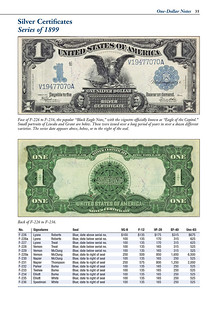

The first edition of the Guide Book of United States Paper Money was published in 2005, with updated editions released in 2007, 2010, 2014, and 2016.
Authors Arthur and Ira Friedberg are well known in the numismatic world. They have been professional numismatists for more than 30 years. Both joined their father's family firm, The Coin & Currency Institute, after college. Since then they have established themselves as award-winning authors, coin dealers, researchers, and numismatic consultants to numerous governments and organizations.
The Guide Book of United States Paper Money covers notes from $1 to $10,000 face value; Fractional Currency; Treasury notes of the War of 1812; encased postage stamps; error notes; signatures on U.S. currency; uncut sheets; and other hobby topics. It includes a glossary and a bibliography for further research.
The book may be borrowed for free as a benefit of membership in the American Numismatic Association, through the Dwight N. Manley Numismatic Library. ANA members receive a 10% discount on copies purchased from Whitman Publishing, the Association's Official Supplier.
A Guide Book of United States Paper Money, 6th edition · By Arthur L. and Ira S. Friedberg; introduction by David L. Ganz · ISBN 0794846350 · Full color, illustrated · 6 x 9 inches, softcover, 416 pages · Retail $24.95
For more information, or to order, see:
https://www.whitman.com/store/Inventory/Detail/A-Guide-Book-of-United-States-Paper-Money-6th-Edition+0794846351

NEW BOOK: INDIANA OBSOLETE BANK NOTES AND SCRIP
Author Wendell Wolka reports the availability of his new e-book on Indiana obsoletes. Congratulations! -Editor
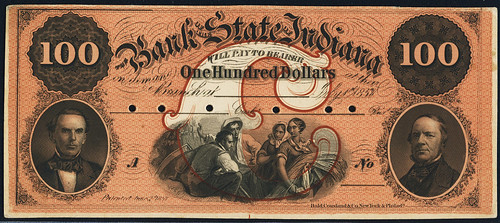
A History of Indiana Obsolete Bank Notes and Scrip
by Wendell Wolka
 Finally (authors knowing the usual path of self-published works are now allowed to snicker at that choice of words) I am happy to announce the availability of a new catalogue covering the obsolete bank notes and scrip of Indiana; the first since 1978.
Finally (authors knowing the usual path of self-published works are now allowed to snicker at that choice of words) I am happy to announce the availability of a new catalogue covering the obsolete bank notes and scrip of Indiana; the first since 1978.
Published as a PDF file and available on either a CD or flash drive, this 900 page e-book lists 450 issuers, over 2800 individual note and scrip descriptions, and has nearly 1400 full color illustrations. As a PDF file, it is fully searchable by key word, phrase, or page number and illustrations can be enlarged to look at smaller details. Those needing hard copy can print out pages, sections, or even the entire book if so desired.
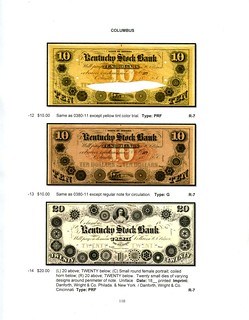
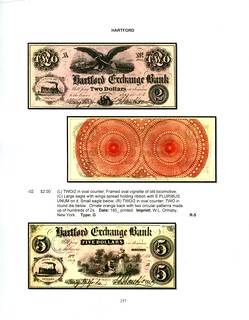
The use of modern technology also allows an attractive price point of $34.95 postpaid; less than one third the price of a comparable traditional format book. Those interested in obtaining a copy of this new e-book may do so by sending a check or money order for $34.95 to Wendell Wolka, PO Box 5439, Sun City Center, FL 33571 or using PayPal (using email address purduenut@aol.com). PLEASE SPECIFY EITHER CD OR FLASH DRIVE as the preferred media when placing orders.
NEW BOOK: RAILROAD STOCKS AND BONDS, 3RD ED.
Researcher and author Terry Cox has published a new expanded edition of his book on stocks and bonds of North American railroads. -Editor
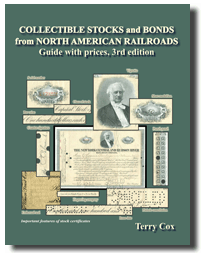 Official title: Collectible Stocks and Bonds from North American Railroads: guide with prices, third edition
Official title: Collectible Stocks and Bonds from North American Railroads: guide with prices, third edition
ISBN: 0-9746485-1-4
Published by:
TCox & Associates, Inc.
4891 Independence St, Suite 190
Wheat Ridge, CO 80033
e-mail: tcox@coxrail.com
Street price: $45 to $50
Available in new form from scripophily dealers and from any local bookseller by special order
Bookseller and dealer discounts available.
Pages: 576 with approx 142 photos
Format: 8½ x 11 inches, 1.15 inches thick
Shipping weight: 4.1 pounds
Binding: perfect (flat spine)
Cover: paper
Barcoded with ISBN (no embedded price)
Case quantities: 5 copies per case (16 lbs, double-boxed)
The Third Edition includes ALL stocks, bonds and related certificates discovered up to mid-September, 20018. The catalog covers all railroad certificates known to have been issued in the United States, Canada, Mexico, Guatemala, Honduras, El Salvador, Nicaragua, Costa Rica, Panama, Puerto Rico, Cuba, Jamaica, and all Carribean Islands.
The second edition includes descriptions of 21,603 certificates, vastly enlarged since the second edition. These certificates represent 8,361 companies.
For more information, or to order, see:
https://www.coxrail.com/third-edition.asp
Cox will be speaking and have a table at the upcoming National Stock Certificate, Bond, Paper money & Autograph Show at the Crowne Plaza Hotel in Herndon, Virginia January 25-26, 2019. For more information on the show, see: Bob Schell Stock Certificate, Bond, Paper Money & Autograph Show (http://www.rsschell.com/) -Editor

JOURNAL OF EARLY AMERICAN NUMISMATICS
The latest issue of the Journal of Early American Numismatics (JEAN) has been published. Here's the press release and additional comments from its editor, Christopher McDowell. Thanks! -Editor
 The second issue of the Journal of Early American Numismatics (JEAN) has been published and
mailed to subscribers. At 211 pages, JEAN 1.2 features six articles by four authors. Gary Trudgen
presents a series of three pieces: "Walter Mould: Convicted Felon," "The People vs. Counterfeit
Coppers," and "Samuel Atlee's New York City Brewery and Mint." David Gladfelter writes about
the origins of the Colonial Newsletter in "From Little Acorns." Journal editor Christopher
McDowell corrects the previous scholarship on Rhode Island Ship Medals with his deep-dive, "A
New Look and Fresh Theory on the Origins of the Rhode Island Ship Medal." John Kleeberg
closes out the issue with new evidence and interpretation in "The Continental Dollar: British
Medals or American Coins?"
The second issue of the Journal of Early American Numismatics (JEAN) has been published and
mailed to subscribers. At 211 pages, JEAN 1.2 features six articles by four authors. Gary Trudgen
presents a series of three pieces: "Walter Mould: Convicted Felon," "The People vs. Counterfeit
Coppers," and "Samuel Atlee's New York City Brewery and Mint." David Gladfelter writes about
the origins of the Colonial Newsletter in "From Little Acorns." Journal editor Christopher
McDowell corrects the previous scholarship on Rhode Island Ship Medals with his deep-dive, "A
New Look and Fresh Theory on the Origins of the Rhode Island Ship Medal." John Kleeberg
closes out the issue with new evidence and interpretation in "The Continental Dollar: British
Medals or American Coins?"
Annual subscriptions are $60 plus $5 s/h. Subscribers receive two issues per year (over 400 pages of content) in June and December. To subscribe, email Emma Pratte at the American Numismatic Society (epratte@numismatics.org) or call 212.571.4470 x117. ANS Full, Foreign, and Life Associate Members (both new and renewing) may elect to receive JEAN instead of the American Journal of Numismatics.
JEAN accepts submissions on early American numismatics (from all of the Americas) on a rolling basis. If you have an article or would like to pitch one, email a one-page abstract for consideration to editor Christopher McDowell at CRMcDowell@strausstroy.com.
Editor Christopher McDowell adds:
I wish to highlight Gary Trudgen's article on Walter Mould, which I believe will be particularly interesting to those who collect and study New Jersey coppers. While we always knew Walter Mould was a scoundrel, the true depth of his criminal activity in England has not been fully understood until now. In this article, Trudgen, who has spent decades studying these men, reveals how Mould's criminal past caught up with him after he was awarded the New Jersey coining contract. A well-placed article in a New York newspaper by Mould's enemies exposed his past causing his partners in the New Jersey coining enterprise to abandon him just as he had abandoned his wife and children to poverty and death back in England. This article explains for the first time the true events that led to the fracture of the New Jersey coining contract – it is a must read for anyone interested in New Jersey coppers and colonial numismatics.
At the present time, I am very busy working on the June 2019 issue of JEAN. I have already received six fantastic articles for publication in June and expect several others. In all honesty, the June 2019 issue of JEAN is shaping up to be the most significant issue of The Colonial Newsletter / JEAN in its over 50 year history. I am more excited about this next issue of JEAN than any previous issue. Our subscriber base has almost doubled in the past two years and I believe that the recent changes to the journal have resulted in it finally starting to realize its true potential. The future looks very bright for this publication!
JEAN is definitely on a roll. I know E-Sylum readers will look forward to the latest writing on the origin of the Continental Dollar and all the articles in this new issue and those to come later. -Editor
To read earlier E-Sylum articles, see:
JOURNAL OF EARLY AMERICAN NUMISMATICS LAUNCHED
(https://www.coinbooks.org/v21/esylum_v21n22a10.html)
JOURNAL OF EARLY AMERICAN NUMISMATICS FIRST ISSUE
(https://www.coinbooks.org/v21/esylum_v21n30a02.html)

BOOK REVIEW: THE FIRST CONSPIRACY
I'm weird. My favorite part of a book is sometimes the footnotes. For it's in the footnotes and endnotes that one can find leads to still more fascinating information about the topic at hand, be it numismatics or anything else. In this CBS News review of a new book, following a footnote led the author to a counterfeiting scheme and a plot to kill George Washington. Great reading here for colonial-era collectors, history buffs and true-crime fans. -Editor
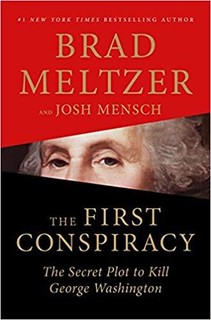 Best-selling author Brad Meltzer found the story behind his latest book, "The First Conspiracy: The Secret Plot to Kill George Washington," in a footnote. He said he took the surprising information to Pulitzer Prize-winning historian Joseph Ellis.
Best-selling author Brad Meltzer found the story behind his latest book, "The First Conspiracy: The Secret Plot to Kill George Washington," in a footnote. He said he took the surprising information to Pulitzer Prize-winning historian Joseph Ellis.
"I went to him and I said, 'Did this really happen?' And it really happened. When it happened, George Washington rounded up those responsible. He took one of the main conspirators and he hung him in front of 20,000 people – the largest public execution at that point in North American history," Meltzer said Tuesday on "CBS This Morning." "He brought the hammer down, was like, 'I'm George Washington. Don't mess with me. I'm going to be on the money one day.'"
So how did the story of the plot get lost in history?
"Hanging happened on June 28, 1776. Guess what was happening in the world? The Declaration of Independence. The British were literally there and this gets lost to it," Meltzer said.
The book details an effort to undermine the American Revolution just before the signing of the Declaration of Independence and with British troops about to invade New York City. The plot connects counterfeiters, leading New York politicians and even the future president's own bodyguards. At the time, Washington had private bodyguards, Meltzer said, who were the "best of the best" from his regiments.
To read the complete article, see:
How author Brad Meltzer uncovered the secret plot to kill George Washington
(https://www.cbsnews.com/news/brad-meltzer-new-book-the-first-conspiracy-plot-to-kill-george-washington/)

To read a Wall Street Journal review (subscription required), see:
'The First Conspiracy' Review: The Skulduggery of King George
(https://www.wsj.com/articles/the-first-conspiracy-review-the-skulduggery-of-king-george-11547077659)
RICHARD BAGG, PHD (1946-2018)
I was sorry to learn this week of the passing of Rick Bagg. His long numismatic career spanned stints at Paramount International, Essex Numismatics, Bowers and Merena, and American Numismatic Rarities. -Editor
"I was very sorry to learn of the passing of Rick Bagg. I and the staff of Bowers and Merena Galleries and American Numismatic Rarities enjoyed working with Rick for many years. He was central to our presentation of many "name" collections including those of Emery May Holden Norweb, the Garrett Collection for the Johns Hopkins University, the Virgil M. Brand Collection, the Louis E. Eliasberg Collection and many others. Rick had a keen sense not only of numismatics but also of marketing and finance. He will be mourned by all of us and all others who were fortunate to know him."
John Pack writes:
I met Rick Bagg on September 1, 1997, the day I arrived at the Bowers and Merena offices for a job interview, in picturesque Wolfeboro, New Hampshire. As I approached the door, it burst open, Rick came barreling out, nearly running right into me. I introduced myself as he navigated around me, hurriedly excusing himself as he continued to the parking lot to have a taste of nicotine before racing back into the office to greet me. I recall thinking that he must be in the middle of something very important. What I came to understand was that I had simply witnessed his one occupational speed. He was one of the most energetic personalities I had ever met. He was intense and always thoughtful. By the end of the week, we were well on our way to being friends.
Richard A. Bagg was born in Pittsfield, Massachusetts, in 1946, a single child of parents who presented him with challenges and disadvantages. While unfortunate on the surface, these conditions forced him from a young age to learn to take care of himself, and in this he gained skills he would employ his whole life, effectively getting a head start in some respects. A dear grandfather who had met Babe Ruth (a detail Rick delighted in sharing) and who had lived well into his 90s, was a stable point of support and inspiration along the way.
A pivotal moment came in high school, where he developed a group of friends from far more advantaged families. For the first time, he saw and experienced a different kind of life, and was inspired from that moment to find his own path into it. Armed with natural intelligence, drive and boundless energy, he found his way. He saw to his own education first, earning a Ph.D in psychology from the University of New Hampshire in 1974.
Shortly thereafter, he decided to explore with vigor his interest in rare coins, and in doing so, he found a career that allowed him to enjoy numismatics, his own appreciation of history and his ingrained nature to collect objects that intrigued him. More importantly, it was a career that provided opportunities to engage with many interesting people, those of all walks of life who continued to challenge him and absorb his energy. To a large degree, he thrived on the excitement these interpersonal dynamics provided and, in turn, it propelled his professional success.
Rick's recognition in numismatics came primarily from his years working as the Auction Director for Auctions by Bowers and Merena, American Numismatic Rarities and Stack's, intermittently from the early 1980s until 2011. During his career, he worked with many thousands of clients, obtaining their collections for auction and guiding them through the auction process. He loved numismatic history and among the consignments he was most proud of was the library of Armand Champa, sold in four sales by Bowers and Merena in 1994 and 1995. Rick deeply appreciated the volumes included in the Champa library for their quality and handsome bindings, but much more so for the legacy of scholarship in American numismatics they represented. Rick assembled his own library of fine numismatic volumes, of which he was very proud.
Rick was an intense colleague and rarely took a break, working days, nights and weekends on any project that he felt required such attention. Still, he knew how to take time for himself when he needed it. He once pointed out to me that he had been fortunate to figure out how to take one year off for every six years he worked. He devoted those times to his beloved wife and son. In more recent years, this included world travel with them, which he very much enjoyed.
Rick was very bright, focused, creative, efficient, witty and very humorous. He paid careful attention to details and nuances, and aesthetics were always important to him. Though we last worked together in 2011, we remained in touch over the last few years. A call to him was always good for a laugh and an unexpected observation. I have had the pleasure of Rick's friendship for nearly half my life and have spent countless hours on the phone with him over the years. It is still hard to imagine that he isn't a phone call away and he will certainly be missed by those of us who knew him best.
From Rick Bagg's web site:
As a Numismatic Advisor, I am involved in all phases of the rare coin business including consulting with collectors, dealers and investors in the purchase and sale of their coins. In a span of four decades as a rare coin specialist and consultant, I have served as negotiator and agent for thousands of clients with several hundred millions of dollars in coins who have sold their holdings through public auction or by outright sale. These clients included professionals of all sorts: doctors, lawyers and others from various backgrounds including sophisticated collectors, dealers, investors and well-known public and private institutions. I have also assembled many high caliber collections worth millions of dollars with complete confidentiality and full disclosure. I appraise collections for estate and insurance purposes and have investment portfolios and collection programs available.
Dave provided this photo of Rick at work in December 2003. -Editor

For Rick Bagg's web site, see:
http://www.richardbagg.com/
To read his Linked In profile, see:
Richard Bagg PhD
Rare Coin Specialist and Consultant
(https://www.linkedin.com/in/richardbagg/)
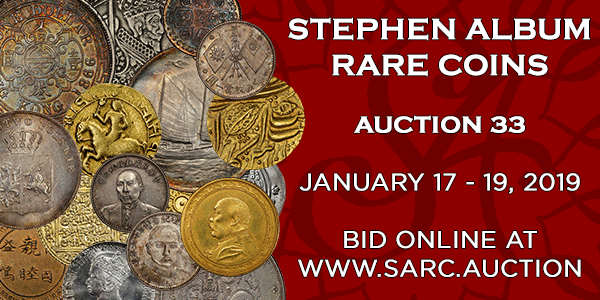
ST. LOUIS STAMP & COIN COMPANY PRICE LISTS SCANNED
The latest addition to the Newman Numismatic Portal is a run of St. Louis Stamp & Coin Company fixed price lists. Project Coordinator Len Augsburger provided the following report. -Editor
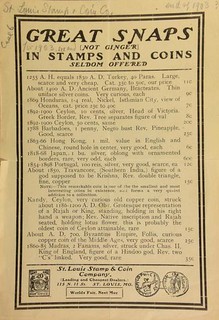 The work of a librarian is endless, with an ever-changing backlog of uncatalogued material and the constant need to prioritize and process the most important content. The American Numismatic Society (ANS) library is no exception, and ANS librarian David Hill has the Sisyphean task of sorting it all out. Among the uncatalogued material, many fixed price lists have not been entered into the ANS library catalog (DONUM). Interestingly, some of these can be found in the ANS multi-volume dictionary catalog (1962 plus later supplements), but for whatever reason, were not included in the eventual computerization of the library catalog. This situation is somewhat relieved with the recent cataloging and scanning of the St. Louis Stamp & Coin Company fixed price lists, c. 1903-1930.
The work of a librarian is endless, with an ever-changing backlog of uncatalogued material and the constant need to prioritize and process the most important content. The American Numismatic Society (ANS) library is no exception, and ANS librarian David Hill has the Sisyphean task of sorting it all out. Among the uncatalogued material, many fixed price lists have not been entered into the ANS library catalog (DONUM). Interestingly, some of these can be found in the ANS multi-volume dictionary catalog (1962 plus later supplements), but for whatever reason, were not included in the eventual computerization of the library catalog. This situation is somewhat relieved with the recent cataloging and scanning of the St. Louis Stamp & Coin Company fixed price lists, c. 1903-1930.
Fixed price lists are among the most bibliographically challenging of numismatic literature as they often come undated, and without regular titles or sequencing. Charles Steigerwalt, the 19th century Pennsylvania dealer, is especially noteworthy (notorious?) in this regard. The situation is somewhat better for the St. Louis Stamp & Coin fixed price lists. Although published without dates, most are numbered and can be attributed within a year or two of publication. There are three distinct series, beginning with the "Special stock reduction circular" (c. 1903-1905), followed by the "Special bargain list" (c. 1903-1908), and then the better-known "Fixed price list" (c. 1905-1930). Also included in the series are unnumbered and undated items such as the "Great Snaps (Not Ginger)" edition, illustrated here.
Link to St. Louis Stamp & Coin Fixed Price Lists on Newman Portal:
https://nnp.wustl.edu/library/publisherdetail/528772
THE BOOK BAZARRE
STACK'S BOWERS AUCTION ARCHIVES IMPROVED
This press release highlights recent improvements to the auction archives at Stack's Bowers Galleries. -Editor
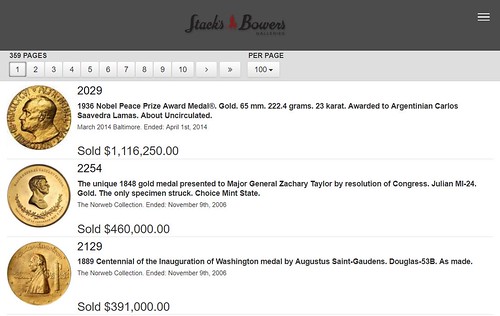
Stack's Bowers Galleries is pleased to announce a complete rebuild and relaunch of their online Auction Archives, available at https://archive.stacksbowers.com/ . The site now features nearly 650,000 past auction records, including many Stack's and American Numismatic Rarities sales dating back to 2002, which have not been available before. Added to the archives are famous auctions such as the Oliver Jung Collection (2004), the Frog Run Farm Collection (2004), the Louis E. Eliasberg, Sr. Collection of World Gold Coins (2005), the Cardinal Collection/A Gentleman's Collection (2005), the Norweb Collection (2006), the Keusch, Snow & Del Zorro Collections (2008), the Philadelphia Americana Sale (2010), and the John J. Ford Collection Parts V to XXI, as well as many others. Thousands of stunning high resolution images have also been added, allowing for close examination of auction lots. Stack's Bowers Galleries is constantly adding to the archive as more data becomes available.
Features of the new Stack's Bowers Galleries Auction Archives include:
- Industry-leading search speeds.
- Easily accessible and mobile friendly through your internet browser.
- Boolean search, allowing users to combine keywords with modifiers such as AND, NOT and OR to produce more relevant results.
- The use of quotation marks to enhance search results.
- Versatile sorting features.
-
Robust filtering capabilities and guided search, with the ability to narrow the search results by:
- Category: (US Coins, US Currency, Numismatic Americana, Ancient Coins, World Coins, World Paper Money, U.S. Postage Stamps, and Minerals, Fossils & Oddities)
- Denomination
- Country
- Grading service
- Grade
- Auction year/title/session
- CAC, Star, Plus
- Sold, passed
All auction records found in the archive are also accessible in Stack's Bowers Galleries' Previous Auction Prices Realized tool, available on all United States coin lot detail pages. This allows bidders to easily identify what similar coins have sold for in previous auctions. This data gives bidders more confidence in their bids, especially when accompanied by the data of multiple independent 3rd party price guides that is conveniently provided within the lot detail pages.
"We invite everyone with an interest in numismatics and numismatic research to visit our site and explore their new access to this extremely important historical information," commented Brian Kendrella, company president. "At Stack's Bowers Galleries, we continue to work toward providing the best client interface and best personal service in the hobby."
Have a look. The filters work very quickly. Above is an image of results for Numismatic Americana, with the highest-priced lots sorted to the top. Search is fast, too. I was able to quickly find lots from my 2006 American Numismatic Rarities consignment. It's nice to know my old friends are still available online. -Editor
To visit the archive, see:
https://archive.stacksbowers.com/
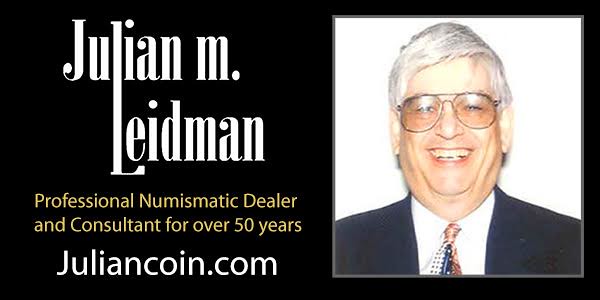
QUIZ ANSWERS: NUMISMATICS AND SPORTS
Last week Pete Smith submitted an interesting (and tough!) quiz on numismatists in sports. -Editor
Vic Mason of Mamaroneck, NY writes:
"In Pete's sports quiz, I know only Kareem Abdul Jabbar (number 9) as an answer to one of the 20 questions. However, as a life-long Detroit Tigers fan, I'll be interested to see who on the Tigers or the San Diego Padres (who met in the 1984 World Series) has been a dedicated coin collector."
Bill Burd writes:
I only know the answer to a couple of them. Just for fun thought I would write and list my adventures.
I skied the last degree (80 miles and 6 days) to the North Pole in 2002 at age 57. After that (from 2003 to 2016) I went on to climb each of the highest mountains in Europe, Africa, Australia and Antarctica. I got to 21,000 feet on Cho Oyu in the Himalayas and 19,000 feet on Aconcagua in South America. I also summited the highest point of each of the lower 48 States.
ANA Edition reader Paul E. Peelle writes:
"I will admit that I know only the answer to number 9 (although I could make some guesses). For number 15, I was on my way to easily surpass 37 marathons until I broke my back (the result of a hit-and-run by a car)--I intentionally got married on Patriot's Day and ran the Boston Marathon for the honeymoon--but no one would ever know about me."
Keith Scott writes:
"I was compelled to respond since I've run more than 50 marathons since 1983. In addition there is over 100000 miles of running, 2000 miles of races ( 1 to 100 miles), and lots of walking.
"I know people who have run 5 day "races", though nothing is as brutal as the Race Across America (bike 7-10 days).
"The numismatic tie is the interesting coin finds such as roadkill cents. I've found four fractional cents with both pieces in close proximity. Zinc cents fracture while copper alloys bend. Think of the probability of car tires randomly moving a cent on edge so it would then be struck by another tire within a second or so.
"What doesn't kill you only makes you stronger."
Thanks. Those responses could help shape a future quiz, but here are all the answers based on what Pete was aware of at the time. Thanks, Pete! -Editor
1. Who won the first gold medal at the 1896 Olympics in Athens?
Trick question! In The History of United States Coinage As Illustrated by the Garrett Collection, it states on page 96:
"Robert Garrett … entered the discus-throw competition at the Olympics, held in Athens in 1896… In spite of having no previous competitive experience, he won the discus throw and became the first American to capture a gold medal in the Olympics. He also took first honors in the shot put, placed second in the broad jump, and tied for second in the high jump."
In fact, no gold medals were presented at the 1896 Olympics. First place winners received a silver medal.
On April 6, 1896, American James Connolly won the triple jump to become the first modern Olympic winner. The discus throw was contested later the same day.
2. In early Olympics there was an event called the "Plunge" that involved swimming a distance underwater. What numismatist took a silver medal in this event?
Edgar Holmes Adams took second place in the Plunge in St. Louis in 1904.
3. What living numismatist has scored ten perfect 300 games bowling?
Mark Borckardt
4. What coin collector is in the American Bowling Congress Hall of Fame and the Professional Bowlers Association Hall of Fame?
Chris Schenkel
5. What numismatist earned a World Series ring in 1984?
Albert Bobrofsky worked as a replacement umpire during a strike.
6. What numismatic author scored seven holes-in-one golfing?
John McCloskey, who died on December 15, 2018.
7. What coin collector was inducted into the International Game Fishing Association Hall-of-Fame?
Ted Naftzger
8. What numismatist climbed 32 mountains greater than 14,000 feet?
John McCloskey, again.
9. What professional basketball player served on the Citizens Coinage Advisory Committee?
Kareem Abdul-Jabbar
10. What member of the ANA Numismatic Hall of Fame was partial owner of the Texas Rangers baseball team?
Amon G. Carter. A later owner was George W. Bush.
11. What numismatist once owned the Los Angeles Lakers in the NBA?
Jerry Buss
12. Name two coin collectors who owned the Los Angeles Kings in the NHL.
Jerry Buss sold to Bruce McNall
13. Who owned the Indiana Pacers basketball team?
Ira, Larry and Mark Goldberg.
14. Who was captain of a national championship cycling team?
Nathaniel C. Fick, Young Numismatist of the Year for 1994.
15. I am aware of a coin collector who has completed 37 marathons. Can you identify him or any collector who has completed more marathons?
Al Boka
To read the earlier E-Sylum article, see:
QUIZ: NUMISMATICS AND SPORTS
(https://www.coinbooks.org/v22/esylum_v22n01a18.html)

ANSWER: WHAT DO THESE IMAGES REPRESENT?
Last week Jeffrey Wing asked for information about the images of an ancient coin pictured on a banknote. The note is a 1944 Greece 100,000,000,000 Drachmai. -Editor
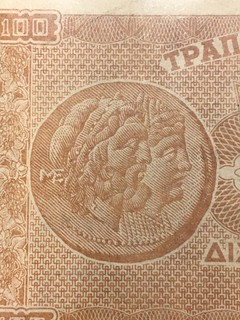
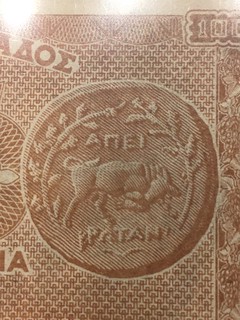
Nikolay Malchev saw the images on our Flickr archive and wrote:
"Epeiros, Epirote Republic AR Didrachm. Circa 234-168 BC. Jugate heads right of Zeus Dodonaeus, wearing a wreath of oak leaves, and Dione, diademed and draped; monogram ΑΥΤΚ to left, monogram of ΑΥΡΚ below / Bull charging to right, ΑΠΕΙ above, ΡΩΤΑΝ below; all within oak wreath. Franke 21; SNG Copenhagen 107; Weber 3024. 9.88g, 26mm, 9h. Good Very Fine"
Click the images above to see the fully commentary. I believe it was taken from an online auction lot listing. but I'm not sure from where. -Editor
Chip Howell writes:
I think I have something for you! This link shows a similar coin with the following description...
Ancient Greek. Illyrian. Silver Epeirote Republic tetradrachm coin, the front with Jugate heads of Zeus Dodonaios, wreathed with oak and Dione, veiled, the reverse with a butting bull, all within an oak-wreath. 238-168 BC (1")
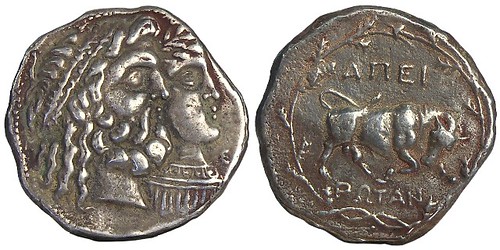
From: Sadigh Gallery's Ancient Greek Illyrian Silver Epeirote Republic Tetradrachm Coin 43152
To read the complete item description, see: Sadigh Gallery's Ancient Greek Illyrian Silver Epeirote Republic Tetradrachm Coin 43152 (http://sadigh.weebly.com/featured-artifacts/sadigh-gallerys-ancient-greek-illyrian-silver-epeirote-republic-tetradrachm-coin-43152)
Chip adds:
"I don't speak Greek (someone else will have to translate the coin's inscription) but I suspect "Dodonaios" relates to Dodone in Epirus, site of an important oracle (second only to Delphi). Dione was another consort of Zeus; both were important in NW Greece. Zeus notoriously took the form of a bull for one of his escapades, but I couldn't find a reference tying it to this region."
To read the Dodonian Zeus Wikipedia entry, see: https://en.wikipedia.org/wiki/Dodonian_Zeus
Thanks! I knew our readers could handle this one. -Editor
To read the earlier E-Sylum article, see:
NOTES FROM E-SYLUM READERS: JANUARY 6, 2019 : Query: What Do These Images Represent?
(https://www.coinbooks.org/v22/esylum_v22n01a10.html)
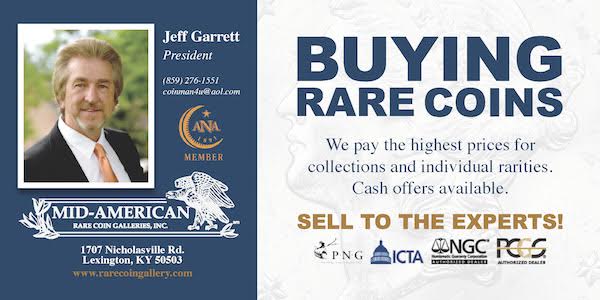
NOTES FROM E-SYLUM READERS: JANUARY 13, 2019
More on The Westerner Newsletter
Ken Bressett writes:
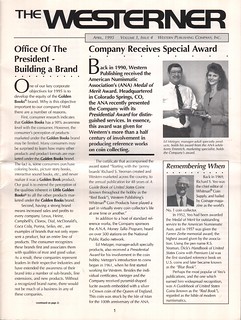 I spent some time today searching for information about The Westerner newsletter to answer to David Lange's query. It was indeed an in-house publication intended solely for employee communication. I am familiar with the earlier editions that I eagerly read each month while I worked at Western Printing and Lithographing Company from 1959-1981. The one that Lange has is apparently that of a new iteration begun in 1995, and dated Volume 1, Issue 4, 1995. It appears to be a bit reduced in quality and content from the earlier version with the same name, and was likely discontinued late in 1995.
I spent some time today searching for information about The Westerner newsletter to answer to David Lange's query. It was indeed an in-house publication intended solely for employee communication. I am familiar with the earlier editions that I eagerly read each month while I worked at Western Printing and Lithographing Company from 1959-1981. The one that Lange has is apparently that of a new iteration begun in 1995, and dated Volume 1, Issue 4, 1995. It appears to be a bit reduced in quality and content from the earlier version with the same name, and was likely discontinued late in 1995.
The original version of The Westerner was 24 pages, printed on high-quality glossy paper, in black with colored highlights. I seem to have saved only Issues number 184 (March 1965) and 197 (April 1966) and could not locate any of the others. In checking with members of R.S. Yeoman's family I found that they too never saved any. We all seem to have read them with interest to learn about fellow workers, but never thought of them as collectibles. There was rarely anything in them of numismatic importance, except an occasional mentions of what was going on in the coin department, or something that Dick and I were doing. By my calculations, the original publication must have been started sometime around 1950.
Thank you! -Editor
To read the earlier E-Sylum article, see:
THE WESTERNER NEWSLETTER
(https://www.coinbooks.org/v21/esylum_v21n52a09.html)
UK Banknote Concept Designs: Endangered Wildlife

Gisele Navarro of NeoMam Studios writes:
The Numismatic Bibliomania Society's E-Sylum recently published an entry featuring the banknote concept designs that we created for QuickQuid - thank you for that! Would it be possible for you to credit the image back to the original source?
Absolutely! Sorry for the omission - the article we saw didn't highlight that. Here is the link to the original source. -Editor
To read the original article, see:
UK Banknote Concept Designs (Endangered Wildlife Edition)
(https://www.quickquid.co.uk/quid-corner/uk-banknote-concept-designs-endangered-wildlife-edition/)
To read the earlier E-Sylum article, see:
ENDANGERED SPECIES BANKNOTE DESIGN CONCEPTS
(https://www.coinbooks.org/v21/esylum_v21n49a25.html)
NFLD = Newfoundland
Last week I asked about the term "NFLD" on a certified coin holder. Nothing generates responses faster than a dumb question like that. -Editor
Ken Berger writes:
"It means Newfoundland. Remember Newfoundland was not part of Canada until 1949. In fact, before joining Canada, there was some talk of Newfoundland joining the U.S."
Dave Ellison writes:
Newfoundland enjoyed self-government from 1855 to 1934 and held Dominion status from 1907 to 1949 before joining Canada as the country's youngest province. They minted their own coinage during these periods.
Aidan Work of New Zealand writes:
" 'NFLD' stands for 'Newfoundland' - which had its own coins from 1867 to 1947. Between 1907 & 1949,Newfoundland was the Dominion of Newfoundland. Newfoundland became part of Canada in March 1949."
Gerry Tebben writes:
"NFLD is Newfoundland, a separate British colony until 1949 when it joined the confederation of Canada. The island off the eastern coast of the Canadian mainland is a wonderfully wild and unfortunately still poor province. You can get there by a long ferry ride from Nova Scotia and, if you're adventurous by car (with a short ferry ride) on the Trans-Labrador Highway from Quebec. Fred Schwan and Brett Irick made the drive a few years ago."
B.J. Herbison writes:
"That's not a Canadian coin, it's from the Dominion of Newfoundland. Newfoundland didn't become part of Canada until 1949.
For some reason Krause lists Newfoundland coins under the heading of Canada, and the Kingdom of Hawaii under the United States, but Puerto Rico gets a separate country heading."
Ken Barr writes:
"I'm sure you've smacked your forehead a few times already on this, and I'll probably be about the hundredth reader to mention that NFLD is an abbreviation for Newfoundland ... leave it to them Canadians, eh?"
Yeah, I'm getting a little woozy about now. Responses also arrived from Jacob Lipson, Ernie Lurvey, John Mutch, Paul Nicholson, Gawain O'Connor, John Okerson, Tim Shisler, Ken Spindler, and Steve Trandem. Thanks, everyone! -Editor
To read the earlier E-Sylum article, see:
NUMISMATIC NUGGETS: JANUARY 6, 2019 : 1938 Canadian 10 Cent
(https://www.coinbooks.org/v22/esylum_v22n01a23.html)
A Vision of the Cashless Future
Dick Hanscom writes:
I read the piece about a world without hard cash. This brought back a memory of a book that I read. In my teens, I read a lot of science fiction. One was a series by Harry Harrison on the Stainless Steel Rat, a professional space-faring thief. He justified what he did because it gave the police a job.
In the same vein, in a world without hard cash, only those intelligent enough to steal electronically will be able to make living. Those poor, computer-skill lacking Neanderthals would have nothing to steal, or nothing to get paid in when they steal something to sell. I suppose they could get a job working for the person that designs the phone call scams. They could man the phones.
It is just another reason (although a poor one) to not go cashless besides the obvious: lack of privacy, and the big one to me, giving the banks a percentage of every transaction on the face of the earth (where do I sign up to be a bank?). We all love Bank of America, Wells Fargo, etc., don't we?
Indeed. Long live coins and cash of all stripes! -Editor
To read the earlier E-Sylum article, see:
LOOSE CHANGE: JANUARY 6, 2019 : Without Hard Cash, What's Left To Steal?
(https://www.coinbooks.org/v22/esylum_v22n01a32.html)
A Nod to Paul Nugget
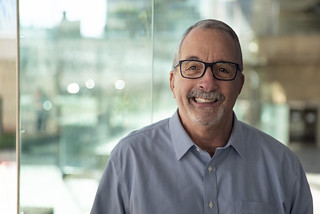 Vic Mason writes:
Vic Mason writes:
I was pleased to hear the good news about Paul Nugget. Paul had kindly helped me a few years ago at Manhattan's Stack's-Bowers, when one day he patiently took the time from his busy work schedule there (I had made no appointment to see him) to answer a series of my detailed questions about what I thought might be ambiguous features of a very rare United States circulated gold coin of uncertain mintage which I had bought in an online auction. It is good to hear that he is doing well, as he joins the excellent team at David Lawrence Rare Coins.
To read the earlier E-Sylum article, see:
PAUL NUGGET JOINS DAVID LAWRENCE RARE COINS
(https://www.coinbooks.org/v22/esylum_v22n01a17.html)
Christian Blom
Frank Robinson writes:
"I haven't seen mention in The E-Sylum about Christian Blom passing away a few weeks ago. Lucien Birkler told me; he was taking care of Christian in his decline. Christian was 83. He was quite a prominent dealer in world and ancient coins decades ago."
I did hear mention of this, but haven't gotten confirmation or been able to find an online obituary or death notice. Can anyone help? Any remembrances to share?
Christian also dealt in obsolete paper money, and I purchased a number of notes from him for my Pittsburgh obsolete paper money collection. I did find the following in a September 26, 1973 letter from Blom to Eric Newman on the Newman Numismatic Portal. -Editor
"After 17 years as a coin dealer, specializing in Ancient coins, I have taken up collecting obsolete US currency, and have assembled about 5000 different notes. My special interest is in very early notes, but not Colonial, and most of my notes are northern, as the Southerners seem to have bought up almost all the decent southern notes."
To read the complete document, see:
Christian Blom Correspondence File, 1973-1993
(https://nnp.wustl.edu/library/book/520588?page=0)
More on the Bond That Still Pays 280 Years Later
I reached out to reader François R. Velde, on whose research last week's article on "The Bond That Still Pays 280 Years Later" was based. Here are links to the full story. Thanks! -Editor
To read the full working paper, see:
https://doi.org/10.1017/S0968565010000168
(https://www.chicagofed.org/publications/working-papers/2009/wp-12)
To read the full published version (subscription required), see:
The Case of the Undying Debt
(https://doi.org/10.1017/S0968565010000168)
To read the earlier E-Sylum article, see:
THE BOND THAT STILL PAYS, 280 YEARS LATER
(https://www.coinbooks.org/v22/esylum_v22n01a31.html)
Columbia & Washington Medal Follow-Up
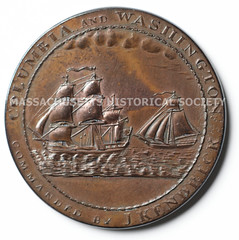
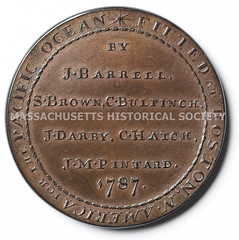
Gene Anderson writes:
Thanks for running my query on the Columbia & Washington medal. Special thanks to Anne Bentley for sharing her knowledge on this subject.
You're welcome. It's always gratifying when we can help answer a numismatic question. -Editor
To read the earlier E-Sylum article, see:
THE COLUMBIA & WASHINGTON MEDAL
(https://www.coinbooks.org/v22/esylum_v22n01a11.html)
Albums for Canadian Small Cents
Gawain O'Connor writes:
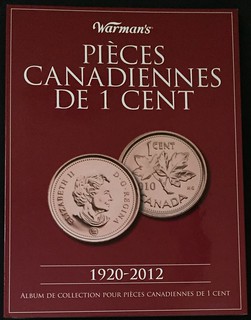 Thanks for Lianna Spurrier's informative video. For collecting Canadian small cents, I highly recommend the Warman's editions because they hold a complete set from 1920-2012 in one 4-page folder. The French language version is ISBN 9781440237980, the English version is ISBN 9781440232619.
Thanks for Lianna Spurrier's informative video. For collecting Canadian small cents, I highly recommend the Warman's editions because they hold a complete set from 1920-2012 in one 4-page folder. The French language version is ISBN 9781440237980, the English version is ISBN 9781440232619.
Thanks for the recommendation. -Editor
To read the earlier E-Sylum article, see:
VIDEO: COIN COLLECTING ON A BUDGET
(https://www.coinbooks.org/v22/esylum_v22n01a06.html)
Chop Mark on a U.S. $20 Bill
Web site visitor Patrick Fenderson writes:
I got this at an American Legion post in Pennsylvania. I didn't know what the mark was until I read your article. Obviously a chop mark.
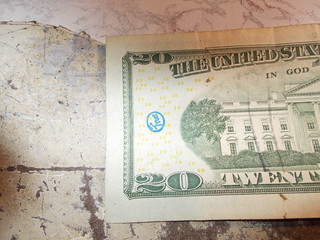
Correct! A number of earlier E-Sylum articles discussed these marks. I don't think we've seen this one yet. Thanks. -Editor
To read an earlier E-Sylum article, see:
CHOPMARKS ON MODERN U.S. PAPER MONEY
(https://www.coinbooks.org/esylum_v17n07a21.html)
Query: Uniface Philippine Treasury Certificate
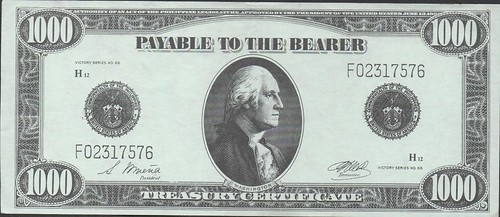
Ken Berger writes:
"Can E-Sylum readers identify what this note is? It is uniface. It measures 8 3/8 inches x 3 1/2 inches. It is Victory Series No. 66. It is signed S. Osmena as President. Along the top, it says "(By) Authority of an Act of the Philippine Legislature, Approved by the President of the United States June 13, 192(9)"
"The note is as colored. The printing is not engraved. The paper has no watermark. It appears to be a light-weight bond paper. Ray Czahor has never seen this note. Jimmy Steelman thinks it is a fantasy note."
Interesting item - I don't think I've ever seen this before, either. Can anyone help? -Editor
George Rode Writes to the Chapmans
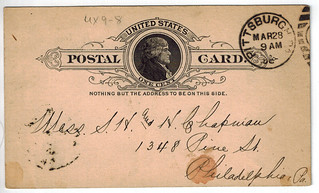
Bill Foley writes:
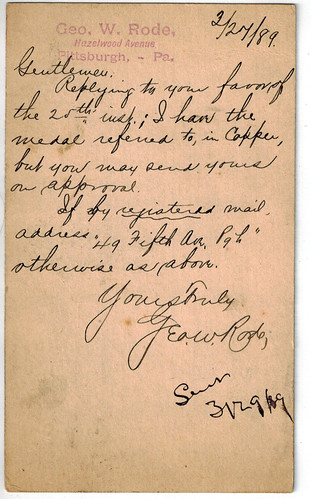 I read your article about George Rode and wanted to send you a scan of a post card I found written by Mr. Rode and addressed to the Chapmans in Philadelphia. Finding the medal referred to in the note would be a fun project, no?
I read your article about George Rode and wanted to send you a scan of a post card I found written by Mr. Rode and addressed to the Chapmans in Philadelphia. Finding the medal referred to in the note would be a fun project, no?
Thanks! Rode was one of the founding members of the Western Pennsylvania Numismatic Society. -Editor
To read the earlier E-Sylum articles, see:
QUERY: ANA PIONEER GEORGE W. RODE
(https://www.coinbooks.org/esylum_v13n20a24.html)
MORE ON GEORGE W. RODE
(https://www.coinbooks.org/esylum_v13n21a23.html)

HARRY BOOSEL'S 1873 OPEN AND CLOSED 3'S
David Gladfelter submitted these notes about author Harry X Boosel and his research on the coinage of 1873. Thanks! -Editor
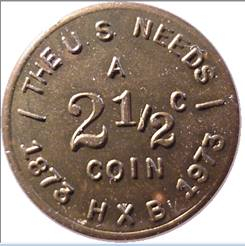
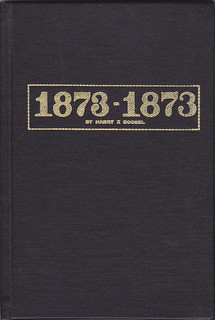
Boosel had an unusual specialty – collecting anything numismatic with the date 1873. Focusing initially on United States coinage of that year, he began writing monthly columns in the Numismatic Scrapbook Magazine beginning in March, 1957. In 1960 he put together, from his columns, a book on the topic titled simply 1873 – 1873, using type fonts resembling the two date styles of that year, the closed 3 and the open 3. The book was published by Hewitt Brothers of Chicago, then publisher of NSM. Next year will be its 60th anniversary.
Circa 1967, Boosel, who had continued writing "1873" articles, published a hardcover edition of 500 copies which included tear sheets of four subsequent supplements. He made a few pen and ink changes before autographing and signing the hardcovers. In all, Boosel wrote at least nine supplements, furnishing hand-marked tear sheets along with the hardcover books. The latest supplement that I have is a tear sheet from the 1987 Coinage of the Americas Conference at the American Numismatic Society in New York on the topic America's Silver Coinage 1794-1891. Boosel's contribution was titled "The Silver Coinage of 1873, and the So-Called Crime of 1873." He died in 1994.
Why all this background? Look closely at the inscription at the bottom of Boosel's 2½ cent token: "1873 HXB. 1973". To my eyes, the 3 on the first date is "closed" and that on the second is "open"!
To read the earlier E-Sylum articles, see:
QUERY: BOOSEL'S 2 1/2 CENT COIN CONCEPT
(https://www.coinbooks.org/v21/esylum_v21n52a08.html)
NOTES FROM E-SYLUM READERS: JANUARY 6, 2019 : More on the 2 1/2 Coin Concept
(https://www.coinbooks.org/v22/esylum_v22n01a10.html)

QUERY: RECOINED SOL UNDERTYPE SOUGHT
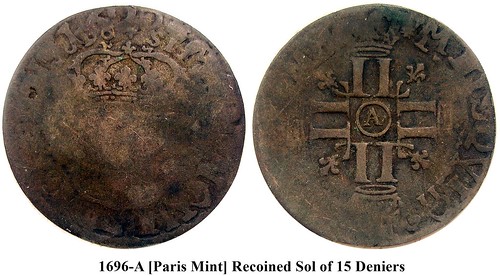
Jeff Rock writes:
I've stumbled on a problem and realize that The E-Sylum is probably the best place to turn, and if you could run the pic with a plea for help I would be most grateful!
The coin is a 1696 Paris Mint Sol de 15 Deniers, popularly called a Recoined Sol in the English speaking world -- the recoined part because these were often struck over earlier French douzains which were worth 12 Deniers. The recoining gave the French crown a 3 Deniers profit on each coin -- strike it with new dies and, voila, it's worth more money! Unfortunately I cannot place the host coin that this one was struck over.
It is clearly dated 1622 (visible at the top obverse, directly above the 1696 date of the overstrike). There are sufficient legends on both sides from the host coin, especially at the right reverse, that an attribution should be doable -- but not by someone with little expertise in world coinage like me! My first guess was one of the Swiss cantons, but that doesn't seem to fit. Any help that the E-Sylum readers can give would be most appreciated! I should mention the host coin is struck in billon.
OK gang, have at it! Can anyone make an attribution of the host coin? Thanks. -Editor

VOCABULARY TERMS: CAST AND CHASED
Dick Johnson submitted these entries from his Encyclopedia of Coin and Medal Terminology. Thanks. -Editor
Cast and Chased. Molded pieces which are subsequently hand worked to sharpen molded relief and infrequently to add engraved lines. This is a method of producing medals (other methods are striking, repousse, niello). Casting and chasing is particularly useful for creating large medallions – and was the method employed by the first medalists of the Renaissance, by Pisanello and others who followed him.
The larger the cast medal or object the greater the need for chasing. Casting by its nature has certain imperfections, both raised (as lines, burrs and bosses) or incised areas (pits, holes and nicks). The imperfections may be in the mold or in the piece cast from the mold. Trapped gasses – air bubbles (occulded gas) – are the most common cause of such imperfections. These tend to locate near relief, lettering or molding inside the rim, and since they were not intended by the artist the need exists for their removal.
The French artist Germain Pilon (1535-1590), famous as a sculptor for his tomb of Henry II and Catherine dé Medici, cast and chased numerous medallions of French royalty in the mid 16th century. Working in the smaller scale of glyptic art he was still able, by chasing, to create a fidelity comparable to contemporary drawings. French medalists who followed Pilon used casting and chasing extensively.
The noted German satirist Karl Goetz cast a great number of his works in large size (over 4 inches) and many of these show evidence of chasing, perhaps by the hand of the master himself. Early goldsmiths would create medals and medallions by casting – even in precious metals – then would chase the pieces. Frey relates that Jewish goldsmiths early in the 17th century cast gold and silver medals of Charles VI, Maximilian I and others, then chased them to give the pieces a look of 200 years earlier. Frey termed such pieces "judenmedaillen."
Many modern medals are made by casting and chasing, but production is slow and time-consuming by this method. The technique is useful for very short runs, or by an artist in his own studio for his own edification.
Evidence of tool marks. Not all pieces that are cast and chased show evidence of their tool marks. The rounded corners of lettering and detail, coupled with lines of tooling, are certainly diagnostics of this class of manufacture. Small casts may not require chasing, larger casts require some. Skillfulness of the chaser is apparent however, the more skilled he is, the less he is apt to leave traces of his hand tooling.
Some inexperienced collectors consider chasing marks as evidence, by their mere existence, the piece is counterfeit. Such, obviously, is not the case for originals being issued by this manner. See cast medals, chasing.
References:
N2 {1958} Babelon, p 33.
Looking for the meaning of a numismatic word, or the description of a term? Try the Newman Numismatic Portal's Numismatic Dictionary at: https://nnp.wustl.edu/library/dictionary
Or if you would like a printed copy of the complete Encyclopedia, it is available. There are 1,854 terms, on 678 pages, in The Encyclopedia of Coin and Medal Technology. Even running two a week would require more than 19 years to publish them all. If you would like an advance draft of this vital reference work it may be obtained from the author for your check of $50 sent postpaid. Dick Johnson, 139 Thompson Drive, Torrington, CT 06790.
JOHN ZUG (1869-1949)
 John Zug (1869-1949), was born on May 1, 1869, Washington, District of Columbia, son of John Edgar Zug (1842-1915), and Frances "Fannie" Hallis Ege Zug (1843-1913). His family estate Tanglewood is located in Bowie, Prince George's County, Maryland.
John Zug (1869-1949), was born on May 1, 1869, Washington, District of Columbia, son of John Edgar Zug (1842-1915), and Frances "Fannie" Hallis Ege Zug (1843-1913). His family estate Tanglewood is located in Bowie, Prince George's County, Maryland.
In 1877, the eight year old John Zug began stamp collecting.
In 1892, he graduated Johns Hopkins University, Baltimore, Maryland, with a Civil Engineering degree.
He worked as a civil engineer, and was a stamp and coin dealer on the side.
In 1892, he worked for the United States government relocating to 322 Occidental Block, Seattle, Washington, to work on harbor dredging there. While there he became the first stamp dealer in the Pacific-Northwest.
On September 20, 1899, he married Katheryn Ella Davey (1880-1953), at Montesano, Lewis County, Washington. They had a daughter Frances. The couple were divorced in Alaska sometime after November 1917.
In 1907, at Boston, John Zug sold his stamp collection at auction.
In 1909, he is reported by some to have purchased 25,000 1909-S VDB Lincoln cents from the San Francisco Mint.
 In 1920, he returned to his family estate Tanglewood is located in Bowie, Prince Georges County, Maryland. There he and his sister Anna (1876-1967) traded as stamp dealers. Benjamin Hudson Collins (q.v.), suggested he become a coin dealer.
In 1920, he returned to his family estate Tanglewood is located in Bowie, Prince Georges County, Maryland. There he and his sister Anna (1876-1967) traded as stamp dealers. Benjamin Hudson Collins (q.v.), suggested he become a coin dealer.
Beginning November 1920 until October 1949 he published a full-page inside back cover advertisement in The Numismatist.
From 1920 to 1946, John Zug sold coins and stamps from his family farmhouse "Tanglewood", Bowie, Maryland. He was known to carry a wide assortment of gold coins.
In 1923 he became ANA Member No. 2123.
In 1927, the Washington Coin Club was founded and charter member John Zug was elected Vice President.
In 1935 he was a charter member of the Baltimore Coin Club.
 In 1948, at the ANA Convention, San Francisco, California, he was awarded the 25 year member silver medal.
In 1948, at the ANA Convention, San Francisco, California, he was awarded the 25 year member silver medal.
Among the coin rarities he owned were : an 1876 proof-like Type I Trade Dollar, an MS67 Red 1909-S VDB Cent.
He died on October 23, 1949 at his daughter Frances' home in Towson, Maryland. He is buried in Holy Trinity Methodist Cemetery, Bowie, Prince George's County, Maryland. Zug was a 32nd degree Mason and Shriner.
To read the complete article, see:
ZUG, JOHN
(https://sites.google.com/a/numismaticmall.com/www/numismaticmall-com/zug-john)
The entire inventory of the Lupia Numismatic Library is for sale. Individual items will be available before the remaining archives are broken up into parcels sold at philatelic auctions in the U. S. and Hong Kong. Check NumismaticMall.com frequently as dozens of new items with estimates will be posted daily until everything is sold.
All inquiries will be given prompt and courteous attention. Write to: john@numismaticmall.com .
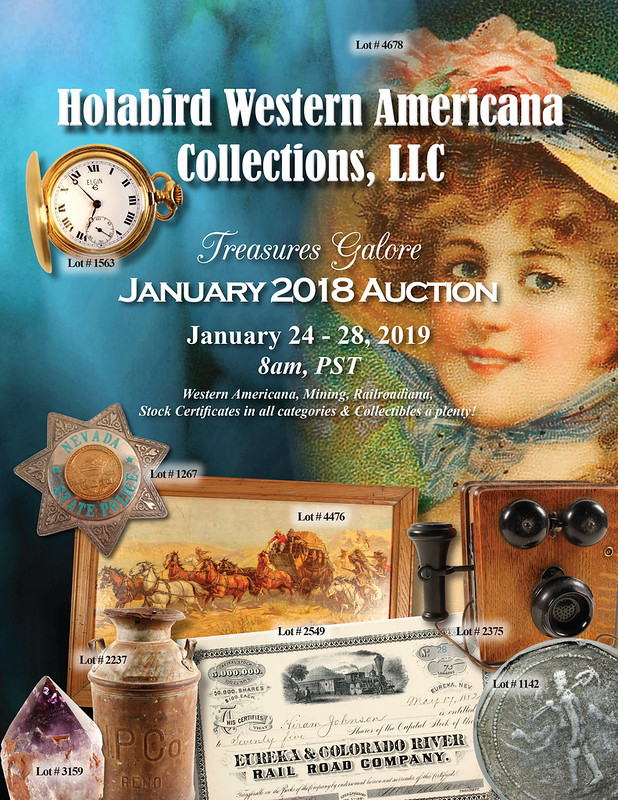
HARVEY STACK'S NUMISMATIC FAMILY, PART 35
Harvey Stack's blog series focuses on living in a numismatic family. Here is part 35. Thanks, Harvey! -Editor
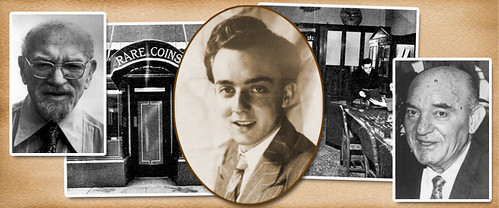
As 1964 began, Stack's was coming off a very successful year in 1963. However, the new year was to bring various challenges to the coin hobby. First of all, Congress realized making U.S. coins – dimes, quarters, and half dollars -- was providing the silver almost at market price. From 1961 to 1963 the price of silver rose by some 20% and the Mint was virtually "giving away" the coins at close to or slightly above the value of the silver in each coin. So, Congress decided to start issuing dimes and quarters after 1964 in a clad metal and also to reduce the amount of silver in the half dollar by 40%. Meanwhile, earlier coins which were 90% silver in many cases increased in value as the price of silver rose.
Traders in precious metals started to buy up standard silver coins and store them away for future sale and possibly melting. This became a distraction to the numismatic hobby. Silver speculators, including the famous Hunt family of Texas, invested in silver coins on speculation. Dealers were flooded with orders to provide silver coins to those who felt the future market would be favorable, and general interest in collecting was deterred by this speculation. Even those who collected classic coins like Morgan silver dollars, thought that the market for silver might go up enough to increase the value of the collections. So many held back from selling either by private sale or at auction.
This interest in precious metals was also evident for gold coins during that year, increasing the demand for what could be acquired here in the United States as import regulations remained challenging.
Adverse publicity affected the auctions of some current collections. We had sales almost every month of 1964, but with the exception of a few, most were general collections, causing collectors to have some trouble filling out their want lists.
One of the highlights was the Philip Ward Collection of United States and Foreign Coins, in gold, silver and copper. It was a super collection of worldwide coins and appealed to buyers as a "real old-time collection." It was not full of high price rarities but was a basic collection of quality coins, providing us the opportunity to help quite a few of our clients. The collection formed by "Irl Baker" was an outstanding offering of United States gold, silver and copper coins that contained some classic rarities. The other collections were much smaller, but for some of our clients offered a chance to build on what they had already collected.
Another factor that influenced the coin business was the tightening by the Treasury's restrictions on importing gold coins without a license, overseen by the Office of Gold and Silver Operations (OGSO). This import licensing was required for all coins imported into United States at the Post Office, Custom House and even for people who bought gold coins overseas and returned carrying them. The rules and regulations were so oppressive that they slowed the importing of gold coins. The problem was that the OSGO never published a list of what could clear Customs and what was prohibited. Dealers and collectors were confused by the lack of clarity and distressed when they tried to bring gold coins from overseas for sale or personal collections. It seemed to some, including me, that the OSGO made up the rules as coins were presented to them for licensing. These rules and restrictions encouraged some to smuggle coins and buyers had to exercise great care not to buy illegally imported gold coins. This had a very damping effect on collecting as others experienced the difficulty of the licensing procedure.
Stack's had the perfect way to test the import regulation, and in my next article, I will tell the story of how that came about.
To read the complete article, see:
Harvey Stack Remembers: Growing up in a Numismatic Family, Part 35 January 8, 2019
(https://www.stacksbowers.com/News/Pages/Blogs.aspx?ArticleID=3238)
To read the earlier E-Sylum article, see:
HARVEY STACK'S NUMISMATIC FAMILY, PART 34
(https://www.coinbooks.org/v21/esylum_v21n52a17.html)
THE BOOK BAZARRE
HETTIE ANDERSON, MODEL FOR SAINT-GAUDENS
I came across an undated article this week about African Americans appearing on U.S. coins. One of the stories is about Hettie Anderson, who served as a model for coin artists Saint-Gaudens and Weinman. -Editor
Hettie Anderson was an African American model who, long story short, was odds-on the one to pose for Liberty on Saint-Gaudens' eagle and double eagle coins, as well as Adolph Weinman's Walking Liberty 50-cent (or half dollar) coin.
The thing is that for many years, the stunning female figure depicted on the eagle coins was a complete mystery for everyone else except Saint-Gaudens' close family, friends, and work colleagues. His family actually tried to keep this information unknown, perhaps because she was black. Luckily, thanks to William E. Hagan's research, the nearly century-old secret was discovered and Hettie Anderson received the proper kudos.
Although other models were receiving credit for Adolph Weinman's Walking Liberty half dollar coin, Weinman described Hettie in all without mentioning her name – probably, once more, because she was African American.
Hettie Anderson was a successful model born in South Carolina in 1873 and relocated to New York City in . At that time, her job was very uncommon for a black woman. She also posed as the Liberty figure on Saint-Gaudens' twenty-dollar gold coin and as the Victory figure for the Sherman Monument.
To read the complete article, see:
The Story of the First African American to Appear on a U.S. Coin
(https://blackexcellence.com/the-first-african-american-to-appear-on-a-u-s-coin/)
There are many mentions of Hettie Anderson found in the Newman Numismatic Portal, mainly from more recent auction catalog descriptions of the St. Gaudens double eagle design. The 1992 Kingswood Franconia sale has some good background on the story and how it was covered up by the sculptor's son Homer Saint-Gaudens. Here's a photo and note about her from the web site of the Saint-Gaudens Historic Site. I added an image of the coin from Roger Burdette's book on the coin. -Editor
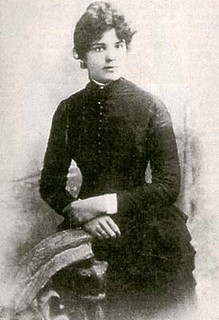

Hettie Anderson was born in South Carolina in 1873. She relocated to New York City, where she became an artist's model, an uncommon employment at that time for a woman of African-American descent. Anderson posed for the Sherman Monument's figure of Victory in 1897; one of her sittings with Saint-Gaudens was captured by the artist Anders Zorn. Anderson was also the model for the figure of Liberty on Saint-Gaudens' twenty-dollar gold piece.
To read the complete article, see:
Hettie Anderson
(https://sgnhs.org/augustus-gaudens-cd-html/Models/Hettie.htm)
Roger Burdette confirms:
Zorn made several drawings with Anderson in the background resting between modeling sessions.
THE COLUMNS OF THE SECOND PHILADELPHIA MINT
A January 12, 2019 Philadelphia Tribune article highlights the classic columns from the second Philadelphia Mint building. -Editor
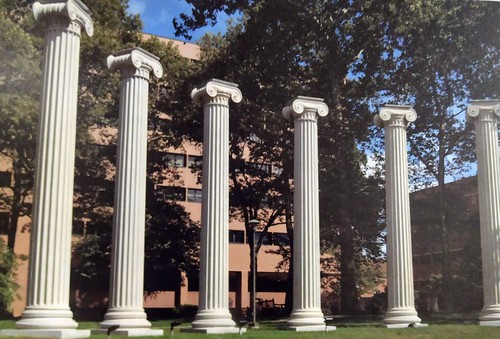
At the entrance of Einstein Medical Center in Philadelphia sits six marble columns that have for over a century withstood the test of time, the elements and man. The Ionic order Greek-style colonnades are all that remains of the 2nd United States Mint in Philadelphia and today stand in geographic and historic isolation of their origin site.
Designed by famed architect William Strickland. Fashioned after the Temple of Ilyssus near Athens, the columns formed one of two porticoes on the Mint Building that stood at the corner of Chestnut and Juniper streets from 1829 until its demolition in 1902. Strickland wrote "it is difficult to preserve all the characteristics of a Greek Temple whose original design and appropriate was solely for the worship of the gods and for the disposition of public treasure."
The Strickland Columns, standing 24-feet tall and three feet wide each, were donated in 1904 to what was then known as the Jewish Hospital and placed at Old York Road where they remained for nearly 100 years. It is theorized that famed architect Frank Furness, who also designed other buildings for the hospital, supervised the placement of the colonnade.
Each marble column is three feet in diameter, fluted and bound at the neck of the capital with an olive wreath. The columns are composed of five elements: an abacus, a capital, a shaft, a base and a plinth. Each abacus and capital weighs approximately 41,000 pounds. The shafts vary in weight from 17,000 to 18,500 pounds. Four of the plinths and bases weigh 4,600 pounds; the two other weigh 67,000.
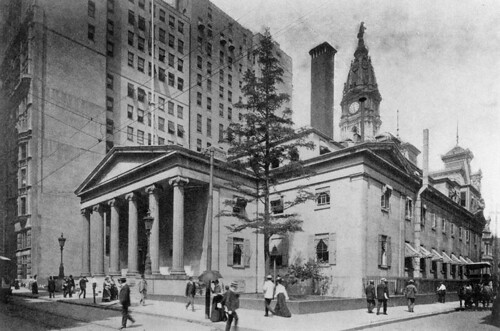
The iconic columns were removed from the Einstein Campus in November 2000 when the entrance at Old York Road was modified and the traffic pattern changed. After nearly a decade and a half in storage, the Strickland Columns were returned to their home along Old York Road as an eminent example of recycling, relocation and restored history.
To read the complete article, see:
Iconic columns at Einstein Medical Center withstand the test of time
(http://www.phillytrib.com/lifestyle/iconic-columns-at-einstein-medical-center-withstand-the-test-of/article_c87e3cd2-7b9d-50ff-9044-082abefb5c92.html)
Earlier E-Sylum articles discussed the restoration of the columns. -Editor
To read the earlier E-Sylum articles, see:
SECOND PHILADELPHIA MINT COLUMNS STANDING TALL ONCE AGAIN
(https://www.coinbooks.org/esylum_v16n16a11.html)
SECOND PHILADELPHIA MINT COLUMN INSTALLATION PHOTO
(https://www.coinbooks.org/esylum_v16n18a08.html)
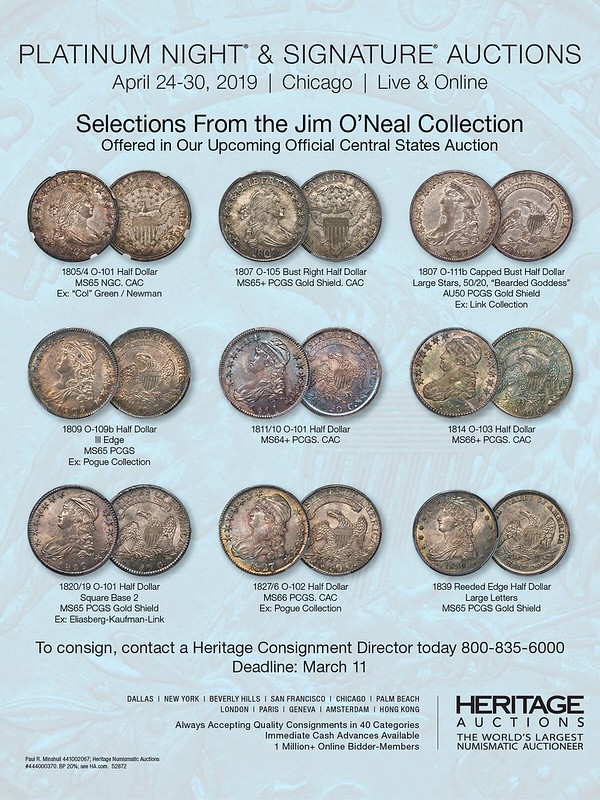
LONGACRE'S LAST LETTER?
Craig Sholley passed along this interesting find - perhaps the last letter written by Chief Engraver Longacre. -Editor
John Dannreuther emailed me with a very neat find by John Kraljevich. While at a Civil War militaria show, John purchased what may well be Chief Engraver James B. Longacre's last letter.
On December 26, 1868, Longacre, who was terminally ill with pneumonia, wrote a brief instruction to Assistant Engraver William H. Key to have William Barber complete raising the reverse working hub for the new Eagle by cutting away the excess metal in the fields which was pushed out in the course of the earlier impressions:
1216 [?] Spring Garden St.
Dec. 26 1868
Mr. Key,
I am confined to my room by a severe attack of pneumonia; If Mr. Barber should be at the Mint to day I would like him to help forward the hub - for the reverse of the new Eagle - he need not cut close up; but merely to lower the broad parts of the table, so as to ready[?] it for the press on the next blow.
James B. Longacre
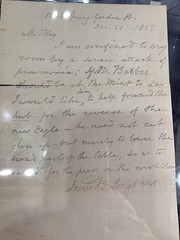 Other mint records show that "table" was generally used to refer to the overall die face surface, so in this case, Longacre was referring to the fields.
Other mint records show that "table" was generally used to refer to the overall die face surface, so in this case, Longacre was referring to the fields.
Removing the excess metal pushed out by previous hubbings was critical as it effectively created a mechanical "dam" which would prevent further impression. In fact, not understanding the need to remove the excess metal had prevented the mint from hubbings full dies until Franklin Peale discovered the process during his 1833 to 1835 visits to the British and French mints.
Sadly, Longacre succumbed to illness and died just six days later on Jan. 1, 1869.

CHICAGO COIN CLUB 1,200TH MEETING
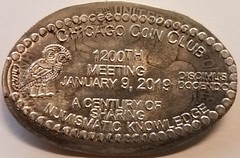

Bruce Perdue writes:
 This year is the centennial year for the Chicago Coin Club. Wednesday evening January 9, 2019 the 1200th meeting took place in downtown Chicago. For those attending an elongated 1919 Walking Liberty half dollar was given along with a business card size plaque commemorating the event.
This year is the centennial year for the Chicago Coin Club. Wednesday evening January 9, 2019 the 1200th meeting took place in downtown Chicago. For those attending an elongated 1919 Walking Liberty half dollar was given along with a business card size plaque commemorating the event.
Bill Burd provided appetizers at a pre-meeting reception. In place of a speaker the members were invited to bring in special numismatic items from their collections. It was a special meeting that I am sure all attendees will remember fondly.
Attached are images of the souvenirs of this momentous event. Also the Chicago Coin Club is selling special 100th Anniversary "Red Books". Members who attend the August 100th Anniversary Banquet will receive a copy of the 100th year Chicago Coin Club "Red Book" as part of their banquet souvenir package.
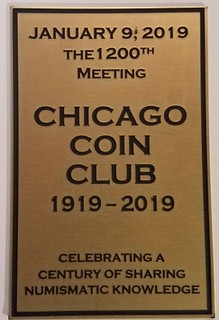

Very nice - great souvenirs of a special event. Email Bruce at bdperdue@gmail.com for a Chicago Coin Club anniversary Redbook order form. -Editor

ANA ENGRAVING COURSE SCHOLARSHIPS AVAILABLE
BEP engraver Laura Stocklin will be teaching a class in art engraving at the 2019 ANA Summer Seminar. This press release announces the availability of scholarships. Images courtesy ANA Archive. -Editor
from American Numismatic Association

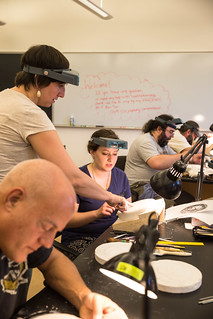
The art of engraving has been around since the dawn of time. From artistic printmaking and mapmaking to storytelling through printed illustrations, engraving has been a profound artistic method for creative minds over the years. Even today, engraving remains as an important artistic expression and one that is seen every day—in our pocket change. Engraved steel dies are used to stamp a metal disk to transfer designs to coins or medals.
Six applicants interested in the medium will have the opportunity to explore the ancient art of hand die-engraving together with more modern processes used to create coins and medals during a week-long, all-expense paid workshop on "The Art of Engraving." The class will take place during the American Numismatic Association's popular Summer Seminar, June 15-20 on the campus of Colorado College in Colorado Springs. The course is led by Laura Stocklin, engraver at the Bureau of Engraving and Printing.
Selected participants will receive a scholarship provided by the Gilroy and Lillian P. Roberts Foundation in honor of Gilroy Roberts, ninth chief engraver of the United States Mint. The scholarship includes tuition, lodging, and meals for one week, and up to $400 reimbursement for transportation costs. Students who successfully complete the first year will be invited back for the second year (June 2020) to continue their study of this fascinating art form (and will receive a second scholarship, as outlined above, to allow participation in 2020).
"My intention for the course is not only to bridge the gap between artists and numismatics with insight into the craft and artistry of the objects of the hobby, but also to further what are slowly disappearing crafts," said Stocklin, who has instructed the course since 1999. "Hand engraving is an ever-shrinking field; as such, expanding exposure to numismatic art forms is paramount to me."
Applicants need not be professional artists to attend the workshop. To apply, send a letter to Seminars Manager Brianna Victor that addresses the following:
- Explain your art background, including education and interests.
- List any exhibits where your art has been shown publicly. Please list any awards your artwork has received.
- List any art organization of which you are a member.
- What, if any, are your numismatic interests?
- What, if any, interest do you have in die making or the coining process?
- Do you have a special project or skill you would like to develop during the class?
- Please submit five examples of your artwork for consideration during portfolio review. Digital images preferred, but not required.
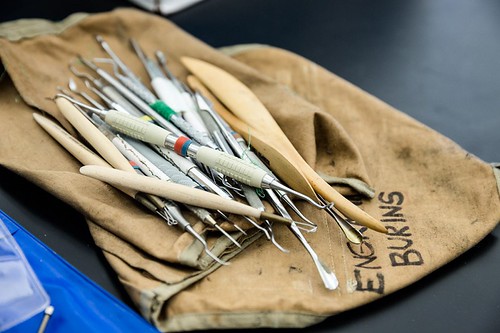
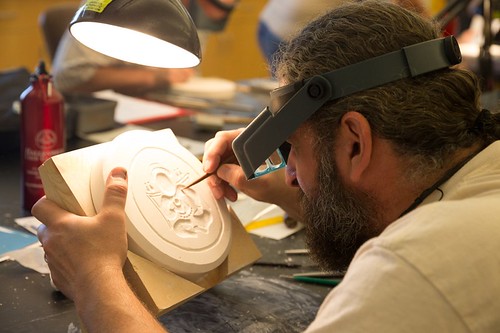
Completed application should be sent to bvictor@money.org with the subject line: "2019 Art of Engraving Scholarship." Electronic submissions are preferred but not required. The deadline to submit applications is Friday, March 15.
This is a great opportunity! You will learn a LOT about the art of engraving and who knows - it could be the start of a great career. -Editor

COIN COUNTERFEITS GET BETTER AND BETTER
A January 10. 2019 Numismatic News article by F. Michael Fazzari discusses the nature of modern counterfeits of rare coins. SPOILER: it's scary! Here's an excerpt, but read the complete article online. -Editor
One disturbing thing about fakes and reproductions is that they tend to get better as the counterfeiters learn new methods of production and universal methods of detection. Back in 1972, when I received my initial training, some folks thought we should reveal all we knew about counterfeit coins while others insisted we keep everything secret so as not to help the counterfeiters improve their product. We took the middle ground and revealed just a few of the distinctive defects ("markers") used to identify a fake.
The group that wished us to keep everything secret turned out to be correct. The more we divulged, the more difficult authentication became as commonly seen defects on virtually all fake coins eventually disappeared. At one Summer Seminar in 1973 or 1974 I showed the class a newly produced $10 Indian and one of the "markers" to use to easily detect it. Within a short period of time, the identical fakes showed up at the authentication service with that defect removed.
I don't mean to alarm readers, but the counterfeiters have taken huge leaps forward in the last several years so that many of the state-of-the-art fakes would fit undetected into a coin collection among the prized pieces.
To read the complete article, see:
Counterfeits get better and better
(https://www.numismaticnews.net/article/counterfeits-get-better-and-better)

MIDDLEBURY COLLEGE ANCIENT COIN DONATION
A generous collector has donated a group of ancient coins to Vermont's Middlebury College. -Editor
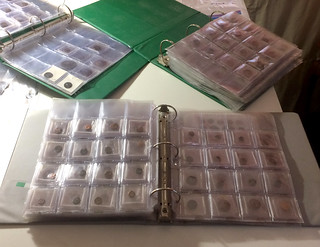 A coin collector from Lewiston, Maine, with no prior connection to Middlebury, has donated more than 1,000 ancient coins to the Middlebury College Museum of Art.
A coin collector from Lewiston, Maine, with no prior connection to Middlebury, has donated more than 1,000 ancient coins to the Middlebury College Museum of Art.
Gary Guimond, who started collecting ancient coins in the 1950s, was looking for an educational institution where his gold, silver, bronze, and electrum coins would be preserved, appreciated, and studied as primary sources of history.
Using online resources, Guimond learned about the Middlebury College Museum of Art and its extensive holdings in ancient civilizations, particularly from the fourth century BCE to the third century CE. The donor approached President Laurie Patton, who put him in touch with Middlebury's Office of Advancement, which connected him to the Museum of Art and its curator of ancient art, who was pleased to accept the gift.
"There are a good number of beautiful and interesting coins from ancient Greece, ancient Rome, the early and middle Byzantine eras, Parthia, and even the Gallic Empire," said Professor Pieter Broucke, the associate curator of ancient art. The collection is particularly strong in coinage from the Roman Empire, he said, with pieces displaying Augustus, Tiberius, Trajan, Marcus Aurelius, Septimus Severus, and the empresses Faustina the Elder and Julia Domna.
The collection includes a bronze Ptolemy II coin, a Republican silver coin, a number of Justinian coins, and a fourrée coin of Caracalla from the third century CE. The collection also contains several Byzantine cup-shaped bronze coins and some medieval French and Eastern European coins, as well as a cluster of lead tokens and pewter objects that served as currency in Renaissance England.
In an email, Guimond explained the motivation behind his gift: "The most important consideration to me is to find a safe home for the collection and for ensuring the coins will be available to students and faculty to display, conserve, study, and research. It feels that Middlebury [is] the right place for all [these pursuits]."
Indeed, Middlebury's museum, with extensive holdings in antiquities, was in a good position to accept and utilize the collection. "The gift constitutes a major expansion of our numismatic holdings at the Middlebury College Museum of Art," Broucke explained. "It will be studied by students and faculty in the Departments of Classics, History, Religion, and Art History for generations to come."
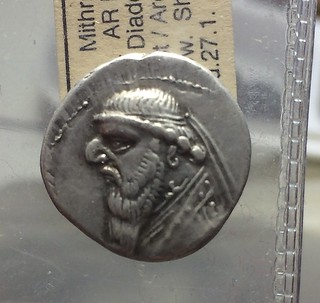 One coin of particular interest to Broucke is a silver drachm of the Parthian King Mithradates II, who ruled from 121 to 91 BCE. (See photo.) The coin, in fine condition, shows the diademed (or crowned) bust of "Mithradates the Great" wearing a torque (or collar) that ends in a seahorse. The coin was struck in Rhagai (modern-day Ray in Iran) in about the year 100 BCE, the professor said.
One coin of particular interest to Broucke is a silver drachm of the Parthian King Mithradates II, who ruled from 121 to 91 BCE. (See photo.) The coin, in fine condition, shows the diademed (or crowned) bust of "Mithradates the Great" wearing a torque (or collar) that ends in a seahorse. The coin was struck in Rhagai (modern-day Ray in Iran) in about the year 100 BCE, the professor said.
The Middlebury Museum is in the early stages of determining how the coins will be used, but Broucke is fairly certain that several will go on view in the Antiquities Gallery, while other coins or tokens, either individually or in small clusters, could be displayed in conjunction with the museum's Byzantine and medieval objects.
In addition, a number of the coins in less-than-fine condition will go into a "study collection," where students and faculty will be permitted to handle the objects and scrutinize them for research purposes, Broucke said.
To read the complete press release, see:
Vast Collection of Ancient Coins Is Gifted to the Museum of Art
(http://www.middlebury.edu/newsroom/archive/2019-news/node/610436)
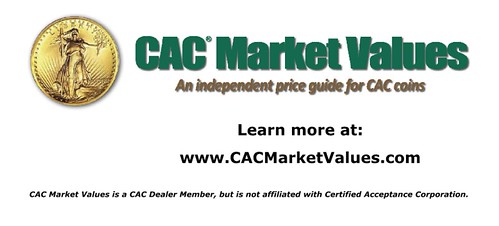
ROYAL MINT TO REISSUE SCARCE 50P COINS
David Pickup writes:
The Royal Mint is reissuing some 50 ps to celebrate the fiftieth anniversary of the introduction of the 50 pence. Perhaps they should reissue other rare coins such as the 1905 halfcrown or 1933 penny!
I had seen this story before but wasn't sure whether it was a hoax. But David did find the Royal proclamation dated 9th November 2018 which refers to these reissues. Here's an excerpt from a recent article about them. -Editor
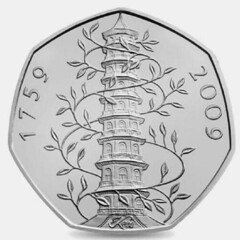 The Royal Mint is to reissue ten rare 50p coins next year, in celebration of the denomination's 50th anniversary.
The Royal Mint is to reissue ten rare 50p coins next year, in celebration of the denomination's 50th anniversary.
According to a Royal Proclamation published earlier this month, the new 50p coins will be released in 2019, and they will all be reissues of previous designs.
The list of 50p coins cited for reprint includes the scarce 'Kew Gardens' 50p, a coin much sought-after by collectors and often considered the rarest 50 pence piece in circulation.
It's not yet known whether the coins will be issued for circulation, or will simply be sold as commemorative, display editions, but it is expected that commemorative collector's editions in Cupro-Nickel, Silver and Gold will be made available. The new coins will presumably be identifiable by having 2019 stamped upon them, and may not be as valuable to collectors while older, original versions are out there.
To read the complete article, see:
Rare 50p coins are being reissued by the Royal Mint – including the Kew Gardens design
(https://inews.co.uk/inews-lifestyle/money/rare-50p-coins-valuable-reissued-royal-mint-2019-kew-gardens-coin/)
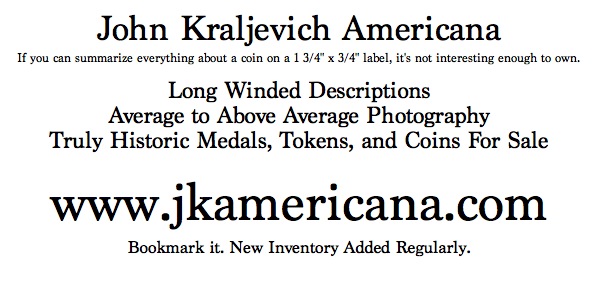
MEDIA COVERAGE OF LUTES 1943 COPPER CENT
Remember the Don Lutes discovery specimen of the 1943 bronze cent we discussed last year? It was sold by Heritage this week for $204,000. It got a lot of coverage in the popular press. Here's a post-sale report from Fortune magazine. -Editor
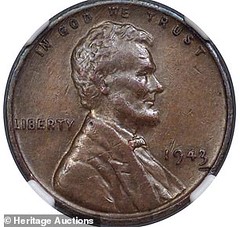

What's a penny worth?
In this case, a rare penny, expected to fetch about $170,000 at auction this week, brought in a little over $200,000.
The 1943 copper penny was minted in Philadelphia and is one of an estimated 10 to 15 in existence. Heritage Auctions spokesman Eric Bradley tells Fortune that the coins are rare because they weren't made of zinc-coated steel, as were others at the time.
Tom Caldwell, of Concord, Mass. was the top bidder of the Philadelphia penny. He says he plans to display it at various coin shows around the country. The money raised from the sale will go to the Pittsfield Public Library, where Don Lutes, Jr., the original owner of the coin, was a patron until his death last September.
Lutes received the penny in 1947 as change for his school lunch. Intrigued, he asked the U.S. Treasury if it had made any copper pennies in 1943 and was told no. He kept the coin anyway.
The only thing I ever got from my school cafeteria was heartburn. See the earlier E-Sylum articles for more background on the coin. What a great gesture to donate the proceeds to a library.
Congratulations to Tom Caldwell and Northeast Numismatics for the acquisition. Visit their table at coin shows this year and check it out. -Editor
To read the complete article, see:
Ultra-Rare Penny Sells for $204,000 at Auction
(http://fortune.com/2019/01/11/ultra-rare-penny-auction/)
Here are some other versions of the story. Dick Hanscom forwarded one from the Daily Mail. Thanks. -Editor
To read the complete articles, see:
Fetching a pretty penny: Rare copper penny Army veteran found in his lunch money in 1947 sells for more than $200K at auction - after claims it would sell for eight times that
(https://www.dailymail.co.uk/news/article-6581223/Rare-penny-sells-200K-auction.html)
Rare coin found in teenager's pocket change could fetch a pretty penny at auction
(https://www.usatoday.com/story/news/nation/2019/01/09/rare-coin-found-pocket-change-could-sell-six-figures/2530599002/)
To read the earlier E-Sylum articles, see:
MORE BREEN AND TAXAY AUTHENTICATION CERTIFICATES
(https://www.coinbooks.org/v21/esylum_v21n28a12.html)
BEARDLESS BREEN ON RADIO WITH 1943 BRONZE CENT
(https://www.coinbooks.org/v21/esylum_v21n30a08.html)
DISCOVERY SPECIMEN 1943 BRONZE CENT GRADED
(https://www.coinbooks.org/v21/esylum_v21n33a16.html)
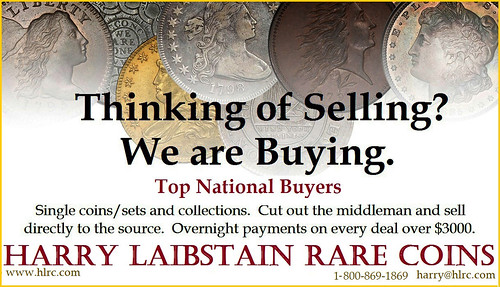
DISTRICT OF COLUMBIA BREADCOINS
A January 12, 2019 Washington Post article discusses "Breadcoins", a token currency for panhandlers, the homeless, and others in need of food aid. -Editor
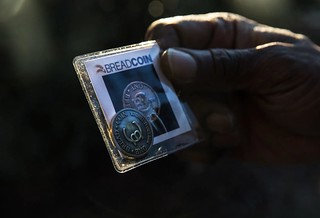 Jeffrey Carter, who is homeless, carried two gold-colored coins in his palm as he approached the Mission Muffins cafe trailer in Northwest Washington to exchange them for a breakfast burrito and apple juice.
The quarter-size coins — each worth $2.20 and inscribed with part of the Lord's Prayer and an image of wheat — were "Breadcoins," a new form of currency in the District intended for people in need.
Jeffrey Carter, who is homeless, carried two gold-colored coins in his palm as he approached the Mission Muffins cafe trailer in Northwest Washington to exchange them for a breakfast burrito and apple juice.
The quarter-size coins — each worth $2.20 and inscribed with part of the Lord's Prayer and an image of wheat — were "Breadcoins," a new form of currency in the District intended for people in need.
Inspired by the popularity of cryptocurrencies such as bitcoin, Breadcoins have circulated in the District since 2016, but they are still relatively unknown. They are an option for people who worry that giving money to those in need might be used to fuel an addiction.
"People don't want to give to people who drink alcohol and use drugs," Carter, 56, said this week as he waited for his food. "It's a new way to give."
Carter got his Breadcoins at the Central Union Mission, where he has been living since August, when he relocated from Connecticut. The shelter serves meals, but using Breadcoins at Mission Muffins gives him more options and allows him to feel like a paying customer.
Central Union Mission disburses the coins to residents who take its workforce development classes. Breadcoin co-founder Scott Borger often distributes the coins to people when he volunteers at the shelter each week.
The coins are the product of his entrepreneurial venture, which encourages people to buy coins for $2.50 each and distribute them to people who are hungry or to participating nonprofit groups. Each coin is redeemable for $2.20 worth of food at one of six vendors in the District, with a combined 11 locations. The value difference keeps the nonprofit organization running.
Some items at Mission Muffins are priced so that they can be bought with one Breadcoin. For example, a Breadcoin will buy a muffin, a twin pack of scones or a cup of coffee. For items that cost more, people can pay with multiple coins or make up the difference with cash.
Borger, who is also an economist at the National Credit Union Administration, said the project gives him a different perspective on the city than his job does.
"In a room with people who are talking about billion-dollar deals, it's good to be reminded on occasion that $100 or even $25 can be a huge difference in someone's budget," he said.
During the commute to her job near Union Station, Melanie Weldon-Soiset frequently gives Breadcoins to people who ask her for money. She started buying the coins about two years ago, when she attended church with the co-founders.
Each coin comes with a list of vendors that accept it. Some people are grateful, some are confused, and still others have rejected the coins, Weldon-Soiset said. She said carrying a few Breadcoins in her purse has taught her to feel more compassionate toward other people's suffering.
To read the complete article, see:
'Breadcoin' is a new currency in D.C. for people in need
(https://www.washingtonpost.com/lifestyle/2019/01/11/breadcoin-is-new-currency-dc-people-need/?utm_term=.8aa56f4aaf70)
For more information, see the Breadcoin web site. -Editor
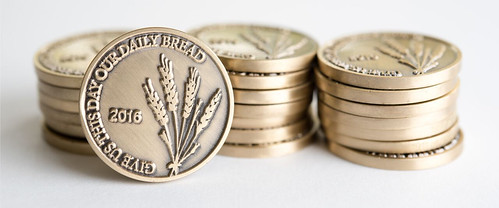
To visit the Breadcoin web site, see:
https://breadcoin.org/
REGINA COIN SHOW FEATURES FIRST NATIONS MEDALS
George Manz submitted this article on the First Nations Medals to be exhibited at the Regina Coin Club spring show and sale to be held on April 13-14, 2019. Thanks. -Editor

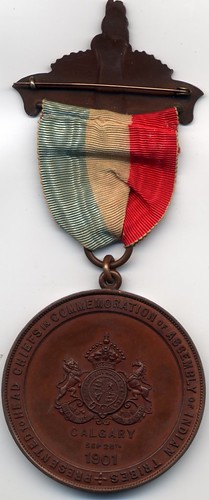
When Queen Victoria died on January 22, 1901, it began a series of events that would have great consequences for the future of the British monarchy and its overseas territories.
With her death, Victoria's eldest son became Edward VII.
Edward's eldest surviving son was next in line to the throne, so he sent the young George on a trip to many parts of the British Empire. The Duke, and his wife, the Duchess of Cornwall and York, left England on March 16, 1901 aboard H.M.S. Ophir. For the next nine months, they visited Gibraltar, Malta, Ceylon, Singapore, Australia, New Zealand, Mauritius, South Africa, St. Vincent, and finally, Canada and Newfoundland.
Melvill Allan Jamieson's book "Medals Awarded to North American Indian Chiefs 1714-1922" chronicled the event: "…As in other parts of the British Empire a gathering of the native tribes was held to offer allegiance to the Royal travelers who were representing the King Emperor."
On September 28, 1901, the Royal party rode in a special carriage two miles west from Calgary to Shagannapi Point, a wide plateau among the foothills overlooking Calgary. In ancient times, it served as a meeting ground between Blackfoot and Cree. Approximately 2,000 representatives of the various First Nations tribes of western Canada were encamped there, including Blackfoot, Blood, Peigan, Sarcee, Stony and Cree. They were wearing their finest buckskins, feathers, leggings and moccasins.
It was a grandiose affair. A detachment of North West Mounted Police accompanied the Royals and the Governor General of Canada, Lord Minto.
The 12 Head Chiefs of the First Nations tribes were presented to the Duke, who greeted and shook the hand of each Chief. A young Sarcee boy then read a statement welcoming the Duke "to the land of our forefathers." Each of the Head Chiefs of the six First Nations then gave a speech in their own languages.
This was followed by a speech from the Duke to the assembled First Nations peoples.
His speech ended with "From the warmth of your reception I feel that you will also long remember this day. In order to specially commemorate it the Great King has ordered that a suitable silver medal shall be struck, and one will be presented to each of the Head Chiefs, which shall always be kept by him so long as he remains in office, and afterwards by his successors."
Each of the 12 Head Chiefs received a 65mm silver medal. The obverse of the medal depicts the busts of their Royal Highnesses The Duke and Duchess of Cornwall and York encircled by a scroll of maple leaves. The reverse shows the Royal Arms in the centre, underneath CALGARY SEP. 28th 1901 surrounded by PRESENTED TO HEAD CHIEFS IN COMMEMORATION OF ASSEMBLY OF INDIAN TRIBES. The medal is suspended by a ring, with a red, white and blue ribbon at the top of which is a brooch showing a male First Nations in a canoe, holding a paddle in both hands.
In addition, 24 similar bronze medals were presented to sub Chiefs.
Both the silver and bronze medals were produced by P. Ellis Company of Toronto.
After his return to Britain, George was proclaimed Prince of Wales in November 1901. He became King George V in 1910, leading Britain until 1936. His granddaughter, Elizabeth II, is currently on the throne.
The medals will be on display at the Regina Coin Club spring show and sale, April 13-14, 2019 at the Turvey Centre, just north of Regina.
First Nations representatives have been invited to cut the ribbon to open the show. Lieutenant Governor of Saskatchewan Thomas Molloy will attend the show as Queen Elizabeth's representative.
George Manz is Fellow of the Royal Canadian Numismatic Association and President of the Regina Coin Club.
For more information on the Regina Coin Club, see:
http://www.reginacoinclub.com/
NEPAL WANTS HIGH-DENOMINATION INDIAN BANKNOTES
From physics we know that for every action there is an equal and opposite reaction. The law governs people, too. While there have been many voices calling for the elimination of high-denomination banknotes to combat the black market economy, there are other voices defending their use. In this article, Nepal is requesting to use high-denomination Indian banknotes. -Editor
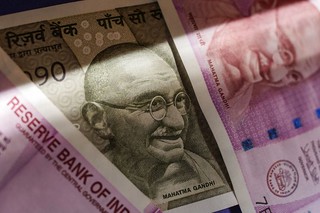 The Nepalese government has asked the Reserve Bank of India (RBI) to make all Indian bills, including Rs 200, Rs 500 and Rs 2,000, legal tender in the Himalayan state, where the Indian rupee is widely used.
The Nepalese government has asked the Reserve Bank of India (RBI) to make all Indian bills, including Rs 200, Rs 500 and Rs 2,000, legal tender in the Himalayan state, where the Indian rupee is widely used.
India has been reluctant to allow high-denomination currency notes to circulate in Nepal, where currently only the Rs 100 note enjoys official acceptance, as this could lead to people stashing illegal cash and fuel the flow of fake banknotes.
The Indian rupee accounts for an estimated 25 per cent of the total money in circulation in Nepal, with the currency also used for the bulk of bilateral trade between the two countries. India is the largest trading partner of Nepal, a landlocked country located between India and China.
Also, the thousands of Indian tourists who visit Nepal every year have shown a preference to transact in the Indian rupee.
However, last month, the Nepalese government banned the circulation of Rs 200, Rs 500 and Rs 2,000 bills, which were introduced after India's November 2016 demonetisation move but are yet to be notified by the RBI for use in Nepal.
Besides Nepal, the Indian currency is also widely used in Bhutan, with people allowed to carry Rs 25,000 in Indian currency to the two countries.
To read the complete article, see:
Why Nepal wants high-denomination Indian bills as legal tender in the country
(https://theprint.in/economy/why-nepal-wants-high-denomination-indian-bills-as-legal-tender-in-the-country/175300/)
PROP MONEY PODCAST
Kavan Ratnatunga passed along a link to an interesting 2017 podcast on prop money. Thanks. Here's an excerpt. It's very well done and has links to several movie clips where prop money is used. Check it out! -Editor
 There's a scene in the buddy cop movie Rush Hour 2, starring Jackie Chan and Chris Tucker, that takes place in a crowded Las Vegas casino. After some tense action, a small bomb goes off near one of the roulette tables and money flies everywhere.
There's a scene in the buddy cop movie Rush Hour 2, starring Jackie Chan and Chris Tucker, that takes place in a crowded Las Vegas casino. After some tense action, a small bomb goes off near one of the roulette tables and money flies everywhere.
A company named ISS Props had provided the money for that scene (and several others) to the filmmakers. The fake money amounted to nearly a billion dollars in fake bills — and the company was surprised when one day, during the filming, two men from the Secret Service showed up to their office. The Secret Service was there because some of the fake cash had gone missing from the set and had started turning up on the Las Vegas strip. CEO of ISS Props, Gregg Bilson Jr., was now facing a serious charge: counterfeiting.
The U.S. has strict penalties for counterfeiting that can be traced back to the 1860s. Around the time of the Civil War, there was a lot of counterfeit money circulating through the country. The federal government needed to assure faith in its currency, so it got serious about cracking down on counterfeit bills. All reproductions of U.S currency became illegal, including photographs of money.
In 1865, a new enforcement agency was formed to help deal with the counterfeiting problem: the Secret Service. That agency is now part of the Department of Homeland Security and is generally associated with protecting leaders and their families. But in the beginning, they were part of the Treasury Department, and their only job was to fight counterfeiting.
The ban on any photographic representation of money was in place for about a century, and this created a problem for people who worked in visual media, which came to include film.
In the early days of cinema, when money was needed in a film, producers often used Mexican pesos. After the Mexican revolution ended (around 1920), a bunch of regional Mexican money that had been created during the revolution lost value and was sold for cheap.
In the second half of the 20th century, the government began relaxing restrictions on the rules around photographing currency and it's now legal to show real money in film. Using real money is great for scenes where you only need to show a small amount in a close-up shot. But for scenes where you need a lot of visible cash, it can be too risky. For those kinds of scenes, fake money is often preferred.
Gregg Bilson's bills for Rush Hour 2 featured many small differences setting them apart from the real things, but they were still too close to reality for the Secret Service. Bilson had to turn over all of this prop money to be destroyed. They also confiscated and destroyed all the electronic files used in creating the fake money.
To read the complete article and listen to the podcast, see:
Money Makers
(https://99percentinvisible.org/episode/money-makers/)
BERLIN GOLD COIN HEIST TRIAL BEGINS
Leon Saryan and Arthur Shippee forwarded this BBC News article about the start of the trial in the case of the giant gold Maple Leaf coin stolen from a Berlin museum. Thanks! -Editor
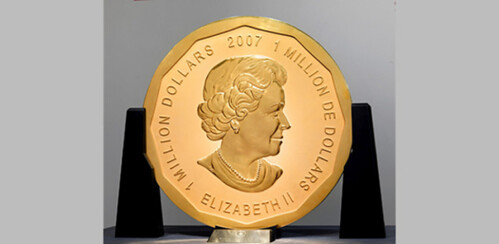
The 100kg (220lb) Canadian "Big Maple Leaf" was made of pure 24-carat gold and was worth €3.75m (£3.4m; $4.3m).
The chief suspects on trial, all in their early 20s, are two brothers and a cousin from a Lebanese Berlin family accused of organised crime links.
A ladder, a wheelbarrow and a getaway car were allegedly used in the heist.
Detectives have not recovered the coin, and believe it has been either cut into pieces or melted down and sold.
It was one of just five such coins minted by Canada, and had been donated to the museum by an anonymous collector.
Prosecutors allege that the three chief suspects climbed onto adjacent railway tracks and used a ladder as a bridge to break into the museum through a third-floor window, which was not alarmed.
The men then smashed through a bullet-proof glass case to steal the coin.
They are believed to have used a wheelbarrow and skateboard to roll the coin away before abseiling from the tracks to their getaway vehicle.
To read the complete article, see:
Giant gold coin trial opens in Berlin
(https://www.bbc.com/news/world-europe-46821706)
Here's some other coverage of the trial, starting with a photo from Art Daily. -Editor
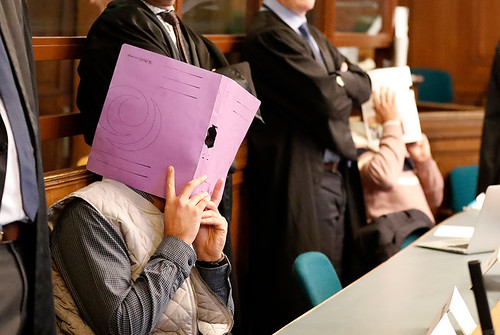
To read the complete articles, see:
Four men deny giant gold coin heist from Berlin's Bode Museum
(http://artdaily.com/news/110453/Four-men-deny-giant-gold-coin-heist-from-Berlin-s-Bode-Museum)
Four men go on trial for giant gold coin heist from Berlin museum
(https://www.theguardian.com/world/2019/jan/10/four-men-to-go-on-trial-for-giant-gold-coin-heist-from-berlin-museum)
Trial For Suspects Accused Of Stealing 220-Pound Solid Gold Coin Begins In Germany
(https://www.npr.org/2019/01/10/684261949/trial-for-suspects-accused-of-stealing-220-pound-solid-gold-coin-begins-in-germa)
To read earlier E-Sylum articles, see:
GIANT GOLD MAPLE LEAF COIN STOLEN
(https://www.coinbooks.org/v20/esylum_v20n14a11.html)
GIANT COIN THEFT FAMILY PROPERTIES SEIZED
(https://www.coinbooks.org/v21/esylum_v21n29a37.html)
LOOSE CHANGE: JANUARY 13, 2019
Here are some additional items I came across in the media this week that may be of interest. -Editor
The Parmelee 1808 Quarter Eagle
Mike Sherman published an article on the PCGS site about a U.S. coin with a pedigree extending back over 125 years. -Editor
It would be the only year of issue for the design, as 13 years would elapse before the next delivery of quarter eagles from the mint. This resulted in the 1808 quarter eagle becoming one of the two or three most difficult U.S. type coins to acquire.
Of the 2,710 pieces delivered that day, perhaps 3% or 4% have survived. One in particular stands head and shoulders above the rest. This is the story of that coin...
To read the complete article, see:
The Story of an American Coin
(https://www.pcgs.com/news/the-story-of-an-american-coin)
No for Clemency for Tom Noe
Ohio Gov. John Kasich is departing office without deciding whether to grant clemency to imprisoned "Coingate" figure Thomas Noe.
Mike DeWine, who succeeds Kasich as governor, could rule later on Noe's petition.
Noe, 64, has served 10 years of an 18-year prison sentence for stealing from a $50 million rare-coin fund that he handled for the Ohio Bureau of Workers' Compensation.
To read the complete article, see:
Coingate figure Tom Noe gets a 'no decision' from Kasich
(https://www.dispatch.com/news/20190109/coingate-figure-tom-noe-gets-no-decision-from-kasich)
Shredded Currency Used in Concrete
The headline of Arthur Friedberg's January 4, 2019 Coin World column is "Concrete could be hiding something that used to be money". When I read that, I thought of sand, beaches and shell money. But that's not what it's about. -Editor
In 2018, the Federal Reserve had to get rid of 8.4 million pounds of the stuff, and selling it as souvenirs does not move it fast enough.
The San Francisco Fed's Dec. 10 blog says its Salt Lake City branch has a more concrete solution for recycling shredded cash — concrete. The banks' office there says it "provides its shredded currency to a local company that incinerates the residue and uses it as energy to fuel their operations. Then the ash is used in a cement mixture process, so every bit of the shred is used."
Interesting development. I never would have thought of that, but if it works, it works. Sounds like a win-win for everyone, and I doubt we'll see fewer macerated currency souvenirs as a result - those gift shop staples are a high-margin product.
So now who says you can't take it with you? Build yourself a mausoleum of money-laced concrete! -Editor
To read the complete article, see:
Concrete could be hiding something that used to be money
(https://www.coinworld.com/news/paper-money/2019/01/concrete-could-hide-something-that-used-to-be-money.html)
The Weinberg 1793 Chain Cent
Ron Guth published an article on some of the blockbuster coins sold at the January 2019 Heritage sale. Here's an excerpt. -Editor
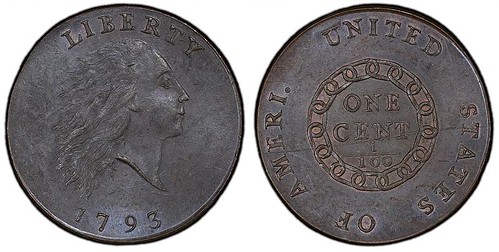
2. Lot 4312. 1793 Chain Cent, PCGS MS64+BN CAC. Sale Price - $1,500,000
This was the second highest price ever paid for a 1793 Chain Cent and the price was very strong for an MS64+BN. The consigner, Alan Weinberg, acquired this coin directly from Large Cent connoisseur, Ted Naftzger, on December 31, 1996, thus this coin never appeared in any of the later Naftzger sales, either public or private, where it would have been a highlight. Truly, an amazing coin.
To read the complete article, see:
Ten Big Ones From The January 2019 Heritage Sale
(https://info606505.wixsite.com/website/blog/ten-big-ones-from-the-january-2019-heritage-sale)


